“We have only 87,000 people altogether, and we are 115 islands. We have 15 types of mangoes, 17 types of banana and four types of coconut. We have no monkey, no snake, no tiger. Here, you are in paradise.”
What they also have in the Seychelles are giant tortoises, coco de mer palms, fabulous forests, beautiful beaches bordered by massive granite boulders, creole food and friendly, laid-back people.
Saturday 6th August to Friday 30th September 2022
Vega has spent almost four months in Seychelles but we, of course, went home to Bristol for June and July, leaving her secure in Eden Marina on the main island of Mahé. When we first arrived in May after our difficult 12 day passage from Chagos, we were delighted to reach civilisation and all its comforts. In the Eden Plaza we found restaurants and cafes, a Spar supermarket well stocked with western goods, a laundry, showers and sailing friends to socialise with.
We soon made contact with various locals; Gustave to help with the engine, Silvain to check the rigging, Max to clean and repair the sails, Sony to see if he could fix the AIS on our plotter. We sorted through lockers, throwing stuff out or packing it to take back to the U.K., to make space for the yet more stuff that no doubt we will acquire along the way.
Only on our last day did we have time to hire a car and get away from the marina, driving across the island on one of the steep, narrow, winding roads through forest to the beautiful beach at Beau Vallon, and then a trek up the mountainside to a viewpoint, the view unfortunately obscured by the low-lying cloud that was covering the peaks. We get so unfit sailing, especially on passage, and were glad to get out to do some hiking. That evening, after only ten days the Seychelles, we flew home to the U.K.
It was, of course, wonderful to be home, to see children and grandchildren, family and friends, and to meet our new grandson Charlie, my son Alex and his partner Sarah’s first baby, who was born whilst we were home. We were fortunate and grateful to stay in the home of good friends Chris and Julia in Bristol whilst they were away themselves, sailing in Scotland.
Hugh returned to Seychelles after seven weeks home whilst I postponed my return for another two weeks to get some hip and leg pain investigated (osteoarthritis in my hip with referred pain down the leg seems to be the cause). It gave Hugh time to get further work done on Vega, to fit a new Aquadrive, new engine mounts etc. I came out bringing new navigation lights and a new AIS unit so there was still ongoing work to be done.
We have loved our time in the Seychelles. I recently read someone describe the Maldives as 50 shades of blue. If so, Seychelles is 50 shades of green. The islands are covered in dense tropical forests with bright, colourful flowering trees and shrubs and every leaf shape and shade of green. Massive granite boulders dot the spectacular landscape and the stunning white-sand beaches. Being south of the equator it’s the cooler time of year now with a consistent temperature of 26 to 28 degrees in the day, far pleasanter than it was in the U.K. when it was in the high 30 degrees on some days. This is usually the driest season here in the Seychelles but it has been exceptionally rainy, although when it rains it doesn’t seem to last too long and, after all, everything is so lush and green here.
The main island in the Seychelles, Mahé, is 16 miles long and up to 5 miles wide, with slopes rising from the sea to a ridge running the length of the island, the tallest peak soaring to almost 3000 feet, its flanks covered in rainforest. Seychelles’ International Airport was built on reclaimed land and runs parallel to the length of the island (a mountain top had to be removed for flight line safety) and it was officially opened by Her Majesty Queen Elizabeth II in 1972. Nearby Eden Island was completed in 2005, also on reclaimed land, and here there is an ‘exclusive marina and gated waterfront community with villas, condominiums and restaurants’, mainly owned by expatriates. Flights approach low over the marina, and you can set your watch by the arrival of the 13:35 Emirates flight from Dubai.
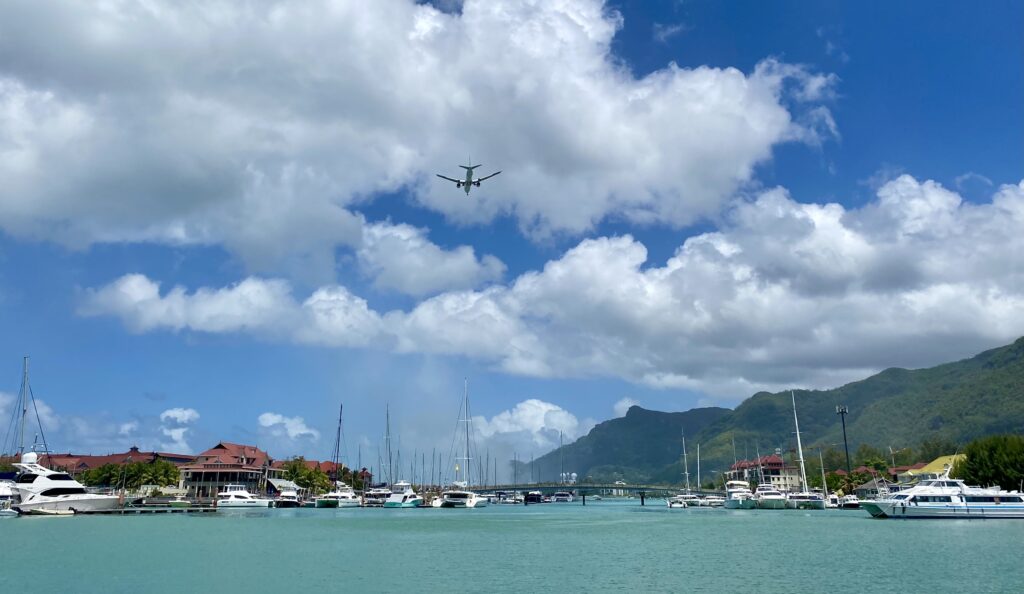
We are within walking distance of the small capital, Victoria, with a mixture of colonial and more modern glass and concrete buildings. The cast iron clock tower known as ‘Little Big Ben’ was made in Croydon and is an exact replica of the one on Vauxhall Bridge Road in London which commemorates Queen Victoria’s diamond jubilee.
Container ships unload at the port and the huge purse seine fishing boats, mostly foreign-flagged, transfer their catches of tuna for export. Much of the food and practically all consumer goods in the Seychelles are imported and their main income is from fishing and tourism.
There is no indigenous population and since it was mostly impenetrable forest, with little flat land suitable for cultivation, the islands were not settled until 1770 when the first French settlers came bringing African slaves, in order to grow spices. Subsequently, large numbers of slaves were brought from Mauritius (Creoles born of African and European parents), Madagascar, Mozambique and, to a lesser extent, India. This has led to a strong mix of ethnic groups and determined the multi-ethnic and multicultural character of the population. The Seychelles were surrendered to the British in 1794 and, although it remains part of the Commonwealth, having been a British colony until 1976, the French language and culture persisted and it still has a predominantly French feel to it. The locals speak French and English, but mainly Creole, all three being their national languages and taught at school. It is a fascinating mix of French, British and African influences. We find the Seychellois to be friendly, laid back and full of humour (when the petrol pump attendant refilling our hire car heard that we were sailing to the U.K. she ordered Hugh ‘get rid of her, I’m coming with you’).
At last, after I’d been back in the Seychelles for 18 days and Hugh for over a month, we finally felt ready to start cruising some of the inner islands. There are about 40 Inner Islands which all lie within 60 miles of Mahé, on the Seychelles Plateau, and which are mainly granite, mountainous and humid, covered with forest. The Outer Islands are flat coral reefs and atolls, and are scattered across the western Indian Ocean lying up to 700 miles from Mahé, too far for us to consider visiting, although they are important breeding sites for turtles and birds.
As we started to leave the marina there was a loud banging noise from the propellor. We headed back to the berth and, having worked out it was the rope cutter on the propellor that had not been sited correctly when the propellor was refitted, arranged for Michael to come the next day with scuba gear and to dive under the boat to refit it properly.
At last all seemed well with Vega and we set off to cover the 28 miles to the islands of Praslin and La Digue, only to make such slow progress in the big seas and strong, adverse winds that we turned back to anchor outside Eden Marina. It seemed we weren’t going to get out cruising after all. Instead we hired a car the next day to explore more of Mahé. I came here 40 years ago when I worked for Shell (installing a computerised accountancy system). I fell in love then with the beauty of the islands, the relaxed attitude and friendliness of the people and a society which seemed to have few racial issues. I’d come across the work of artist Michael Adams then but, being in my 20s, I could only afford a couple of his black and white prints and I was keen now to buy one of his colourful silk screen prints. We were shown around his studio by his wife Heather and eventually chose a print that we both liked. As ‘special customers’ we met the artist himself who regaled us with anecdotes about his time at art college in London with his friend David Hockney.
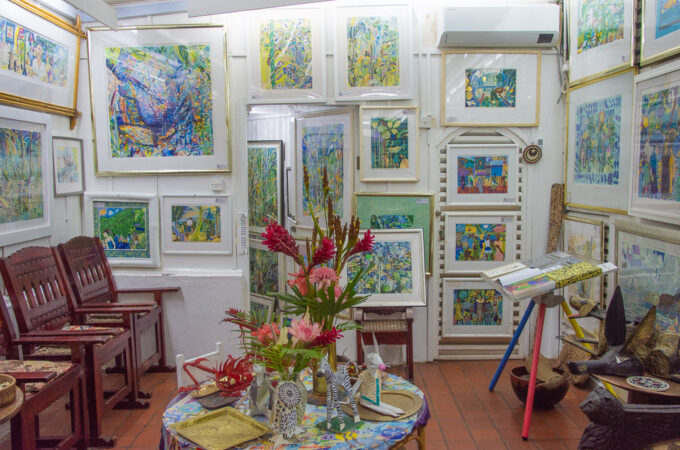
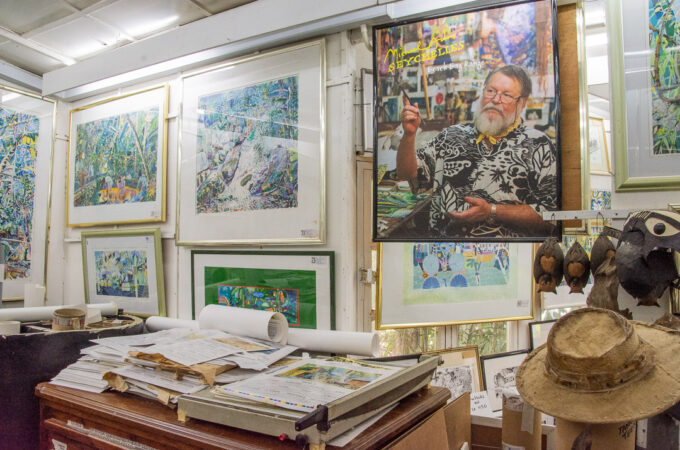
On the whole we eat on the boat as eating out is incredibly expensive in the Seychelles, especially at the marina. In fact the Seychelles is one of the most expensive places we’ve visited on our travels, everything here is phenomenally expensive for tourists (and locals too), whether it’s supermarket shopping, taxi fares, clothing, boat parts or whatever. We did however treat ourselves to lunch on this day out, and had the most delicious meal in a creole restaurant that we just happened upon, ginger fish for Hugh and La Gaulette prawns for me. It was so good we returned a few weeks later when Hugh had the prawns and I had a whole ‘sweet lips’ fish (which was delicious despite the off-putting name).
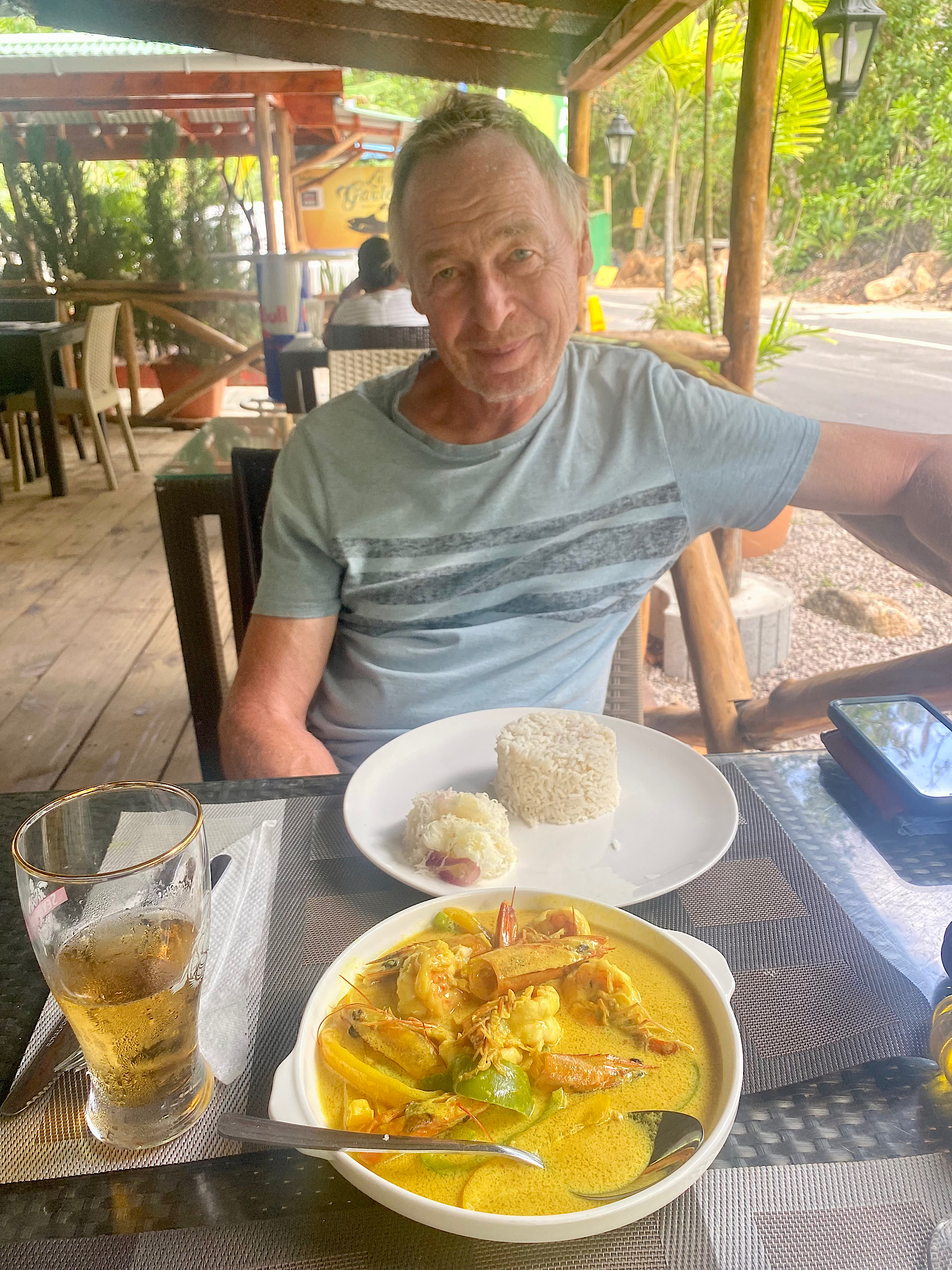
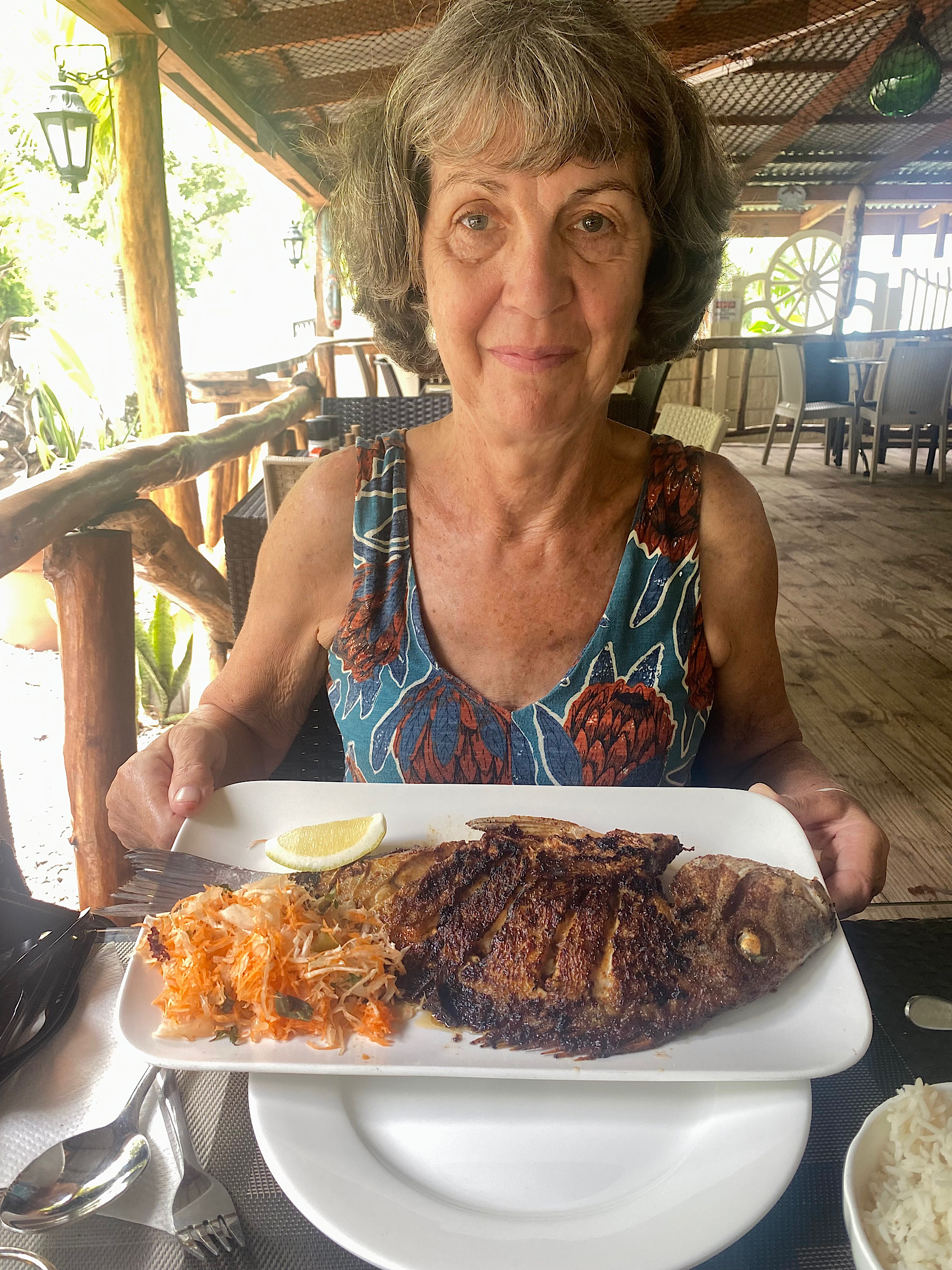
The following day the wind eased off a bit, but even so sailing to Praslin in 15 to 20 knots of wind and big seas I felt rather seasick, having not sailed for so long.
We anchored at Anse Lazio, a beautiful white sand beach with the huge granite rocks which are so characteristic here. It rained for the first three days but we managed to get ashore each day to explore and to delight in the birds, especially the flocks of cheeky Madagascar fodys, the males a vivid red and the females quite drab in comparison.
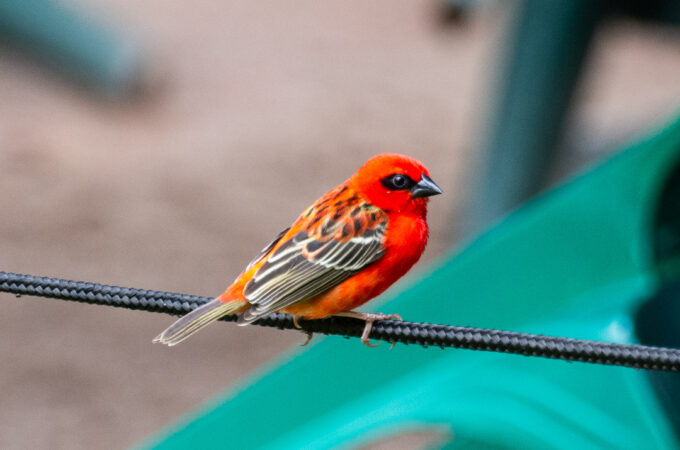
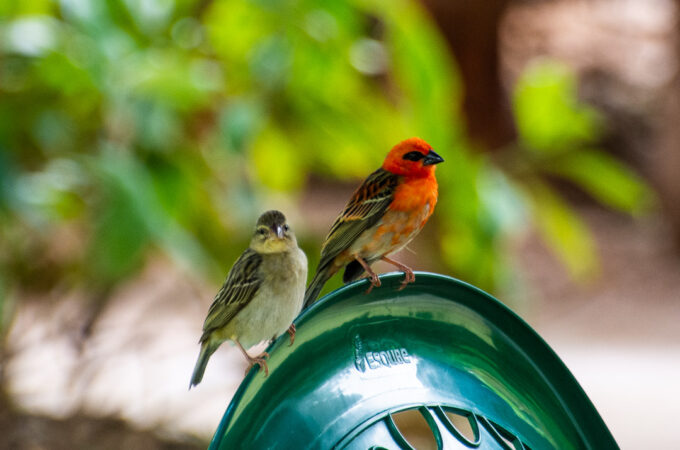
I was keen to swim but when I asked some locals whether it was safe I got a noncommittal reply and advice to stay close to the boat. I later read that in 2011 two tourists were killed in this very bay by great whites, the last fatal shark attack in the Seychelles.
Eventually the rain eased and with sunshine forecast for the week ahead we anchored by Cousin Island. Once a coconut and cinnamon plantation it was taken over as a nature reserve in 1968 specifically to save the tiny Seychelles warbler, which was on the point of extinction due to habitat loss. The coconut palms were cut back in an intensive conservation programme and the island’s native forest flourished once again, as did the bird life and, unfortunately, the mosquito life. We spent a few hours on a walking tour through the forest, the birds so tame they mostly just look at you with mild interest and, with no predators, they can lay eggs on the ground or even on bare branches. Giant tortoises have also been introduced to the island where they can roam freely and Hawksbill turtles return each year to lay eggs on the beach.
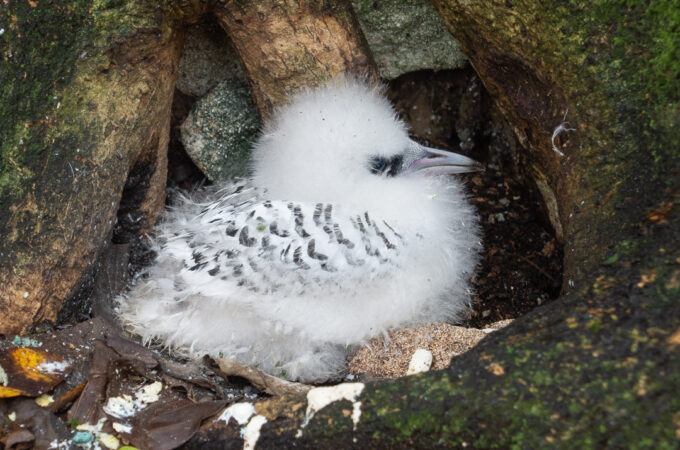
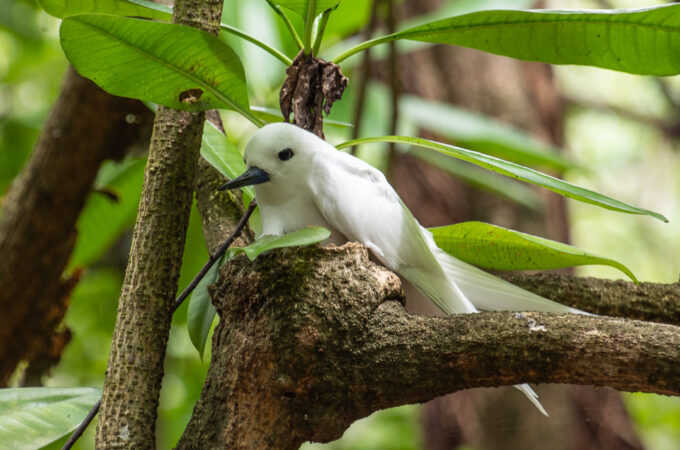
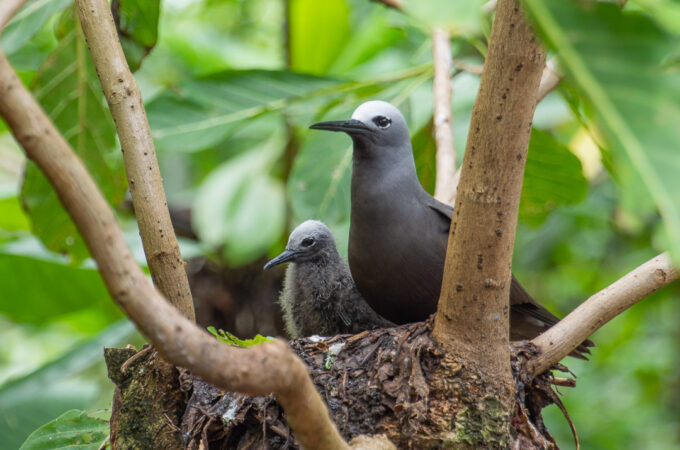
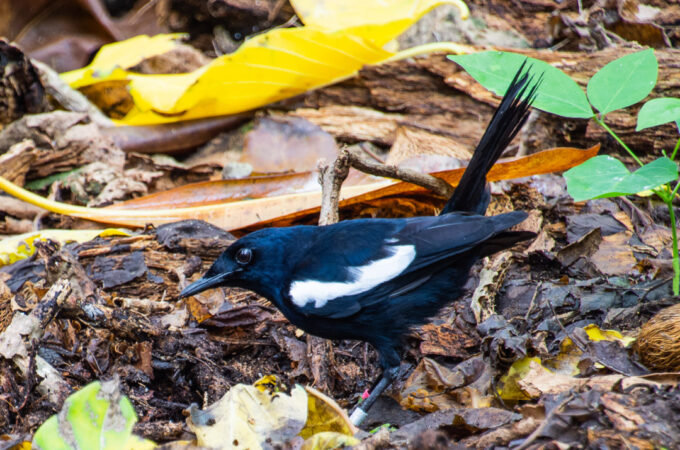
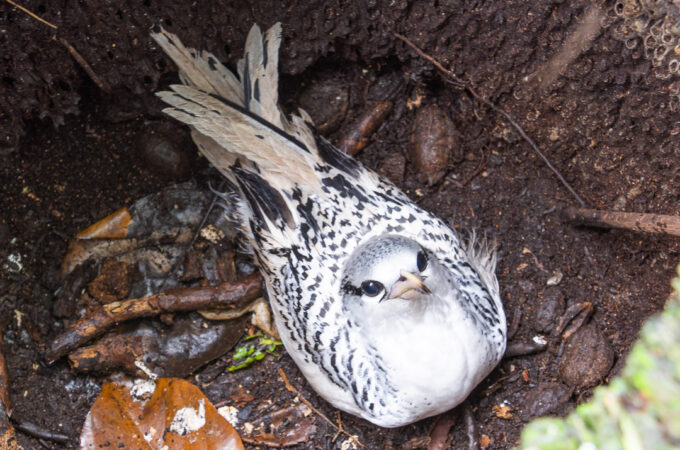
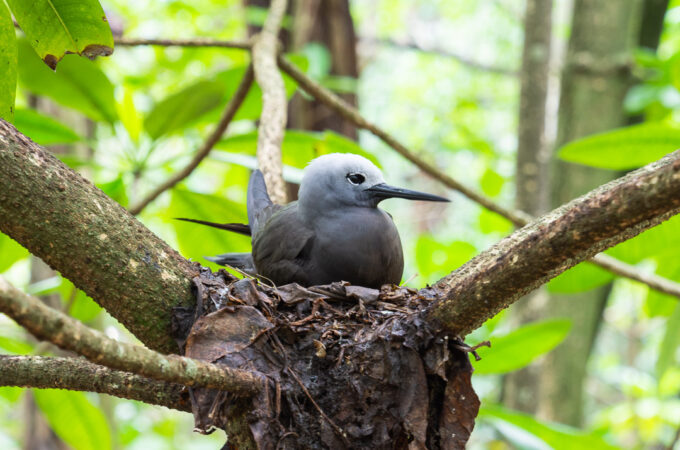
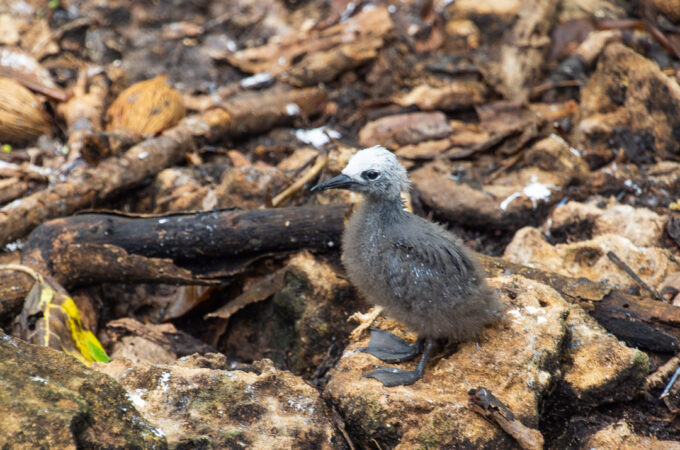
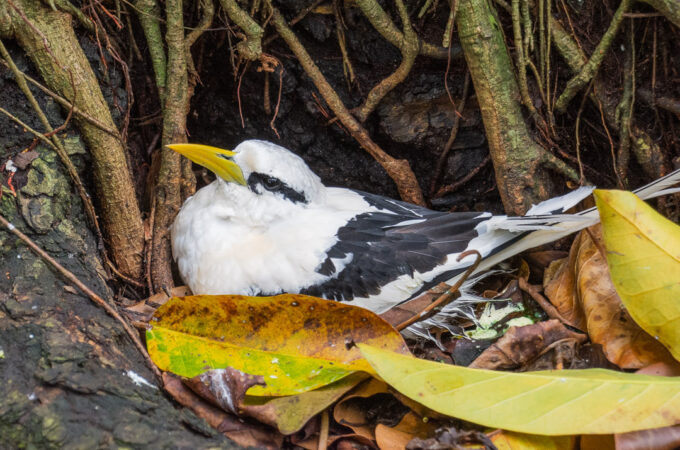
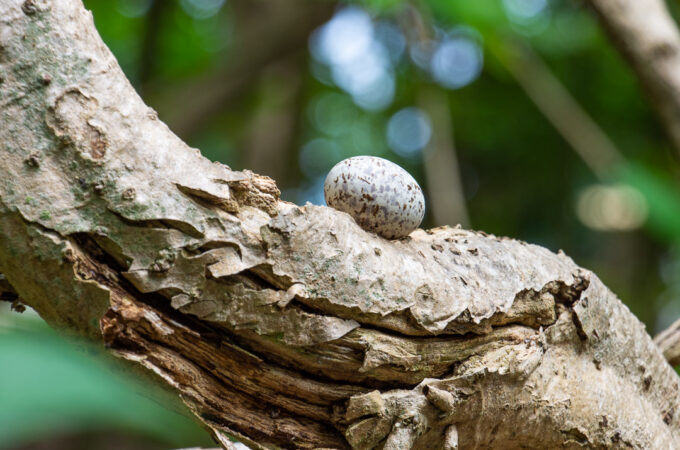
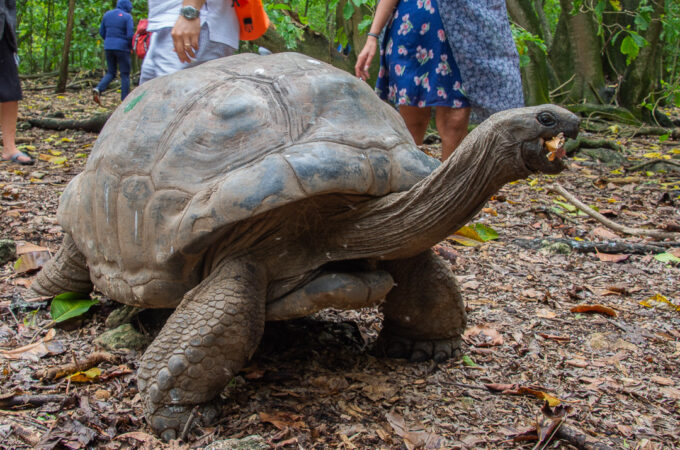
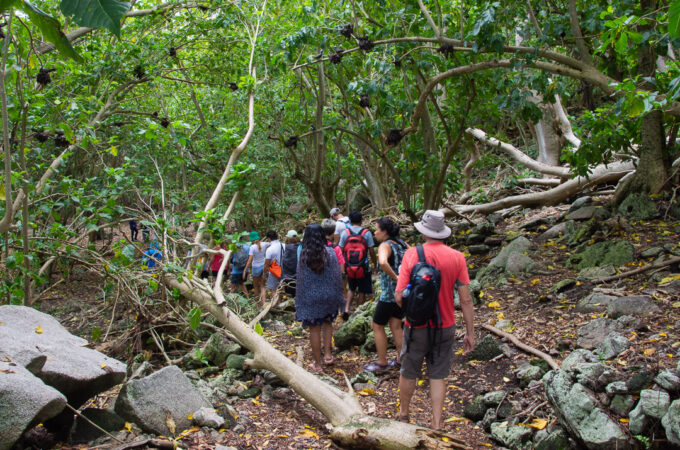
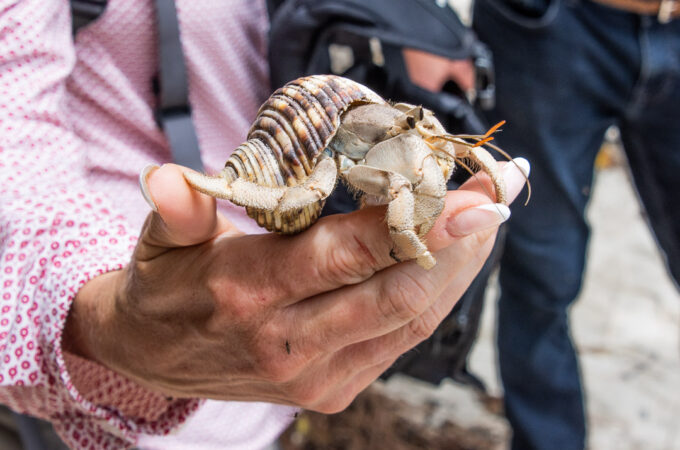
From Cousin island we headed round to the north side of Praslin where we spent three nights at anchor off a beautiful long sand beach, Anse Volbert, also known as La Côte d’Or. From here it was a short hop across to Curieuse island, another national park and home to around 300 giant Aldabra tortoises. Where we anchored a large number of the mature tortoises congregated just by the beach, munching the grass and allowing the tourists to stroke their leathery necks, which they appeared to love. They can roam wild around the island since there are no roads or cars.
We found a quiet spot to have the coffee and bananas we’d brought but were soon spotted by one which came charging over, as fast as a giant tortoise can charge, and we had to move to avoid being crushed by over 100kg of tortoise. Hugh shared some of his banana which was eagerly chomped down. The baby hatchlings and juvenile tortoises here are kept in an enclosed nursery, to protect them from predators such as rats and, importantly, from poachers. Before they are released they are electronically tagged which further helps to prevent poaching.
The Aldabra giant tortoises usually live to 80 to 120 years old although some can live much longer. One day in 2004 the tortoises all disappeared from the grassy area by the beach in Curieuse. The rangers went to feed them like they do every night but the tortoises had left and were heading up into the hills. No one knew why until a day later, 26 December, a tsunami hit the island.
The only other place in the world where giant tortoises live, although a different species) is the Galapagos. Giant tortoises were once common on all islands in the western Indian Ocean including Mauritius and Reunion, until increasing numbers of sailers and settlers visited and removed or killed the tortoises in vast numbers, the tortoises making good food to carry on board ship as they can survive for many months without food or water. By 1840 the Seychelles giant tortoise population had been wiped out on the larger islands and the only surviving giant tortoises in the wild were those on inhospitable Aldabra atoll some 700 miles away. Even here extinction was only narrowly avoided, the giant tortoises saved by appeals for conservation by eminent scientists such as Charles Darwin, and the leasing of Aldabra by Lord Rothschild. Since then the Aldabra tortoises have been introduced to several small islands where they can live wild, as well as some others like Mahé where they are kept in pens (to avoid being a hazard on the roads).
Curieuse Island was once a home to lepers, mostly infected slaves and paupers, until the leper colony was finally closed in 1965. We walked through the mangroves to Anse St Jose where the Doctor’s House is, past some ruins which were once the cottages where lepers lived. The doctor’s house is preserved as a museum, the doctor being Dr Macgregor, an Irish doctor who cared for the lepers in the 1870s and improved the wretched conditions under which they lived.
With stronger winds forecast we picked up a mooring in the shelter of Baie Sainte Anne in the southeast of Praslin. The plan was to visit the Vallee de Mai, a National Park in the centre of Praslin island and renowned for the endemic coco de mer palms that grow there. We spent 3 hours there, the first 30 minutes in the cafe drinking coffee and eating cake, though a large proportion of our cake was devoured by two small zebra doves who hopped onto our table and were so tame they ate from my hand.
We had a wonderful walk on the circular path around the nature park, which is mainly palm forest made up of the six endemic palms of the island which grow here and nowhere else in the world. Most famous is the coco de mer, an endangered species of palm which mainly grow on the islands of Praslin and neighbouring Curieuse (there are also two growing in Kew Gardens). The coco de mer is the world’s largest seed, sometimes nicknamed the ‘love nut’ because of its suggestive shape and considered an aphrodisiac in some countries. The nuts are protected and sale of them is strictly regulated, with prices from around £200 or more in tourist shops (we didn’t buy one).
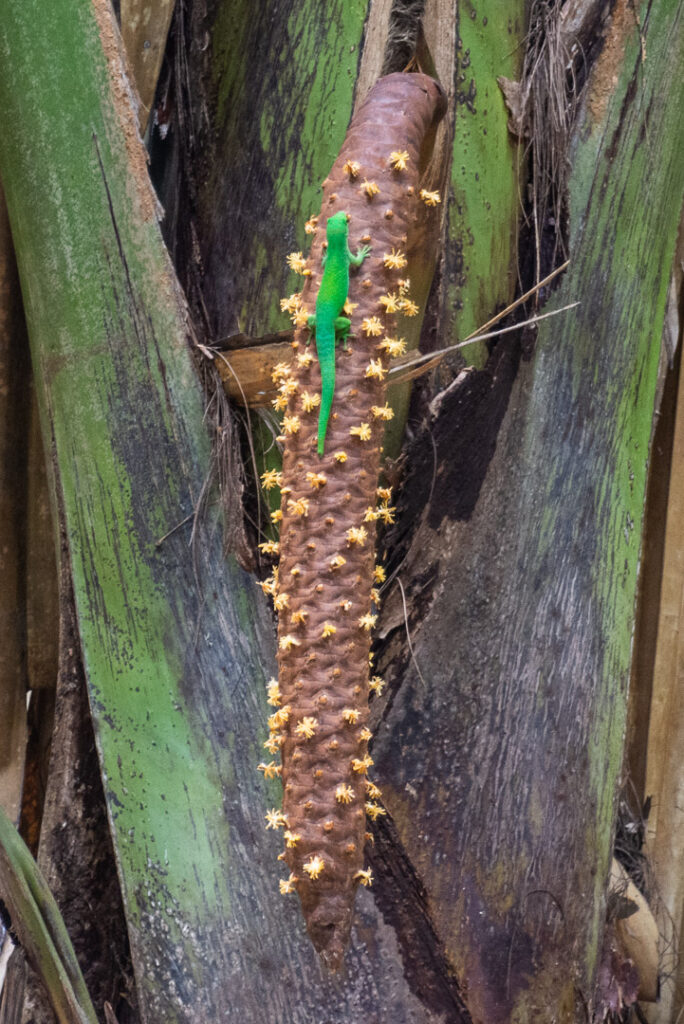
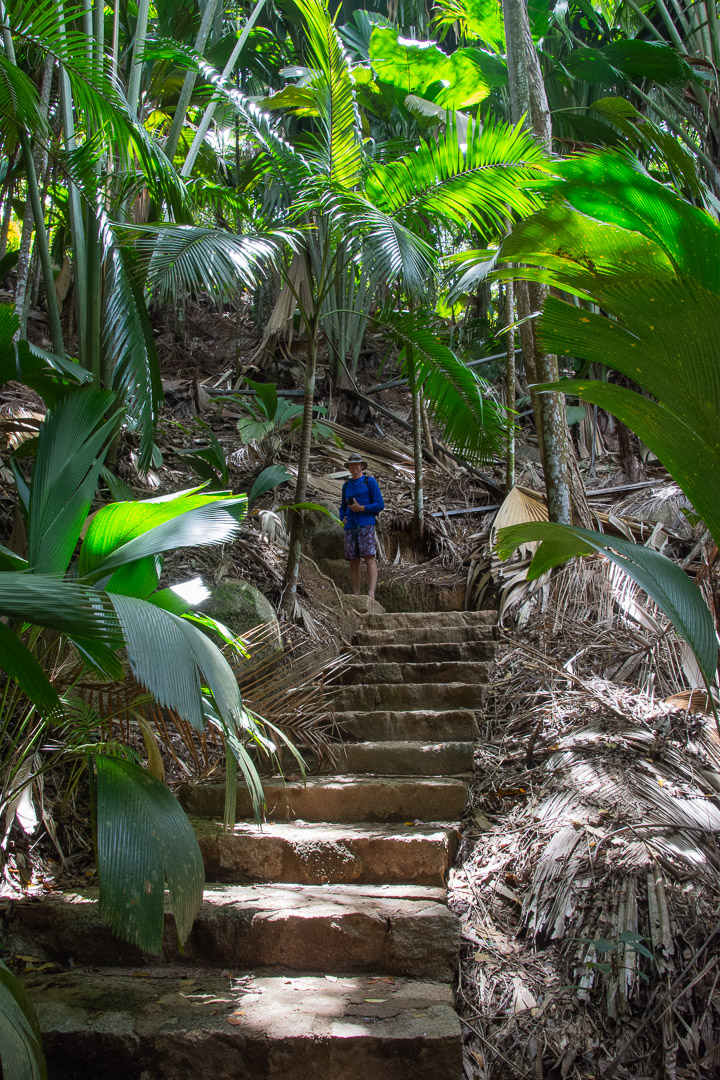
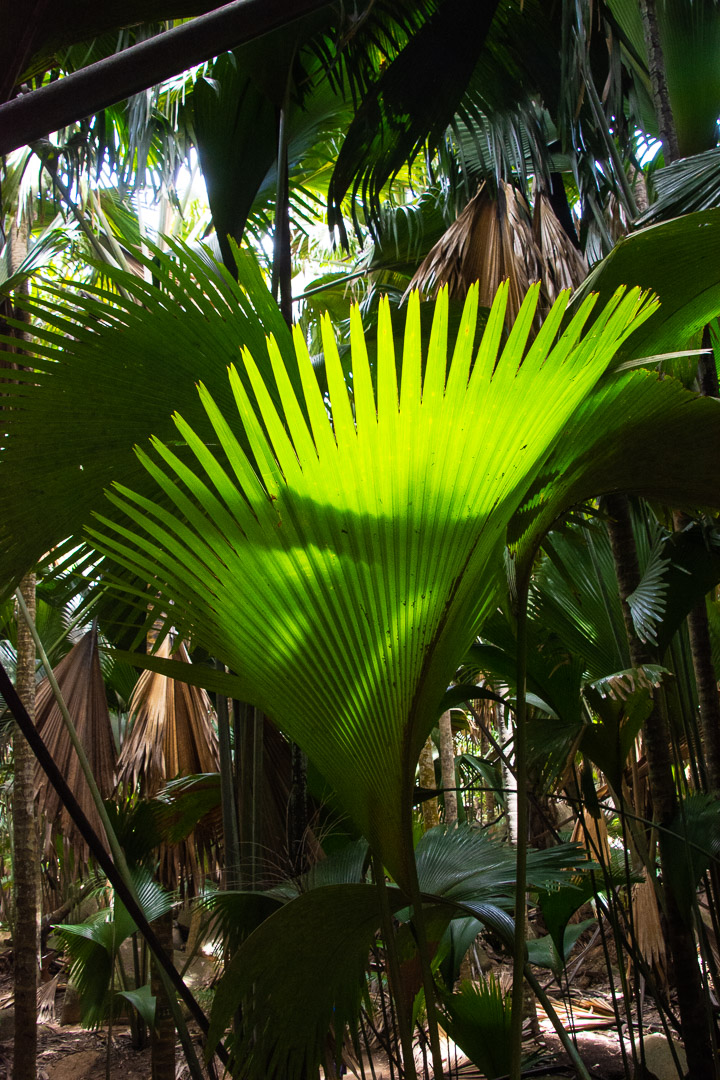
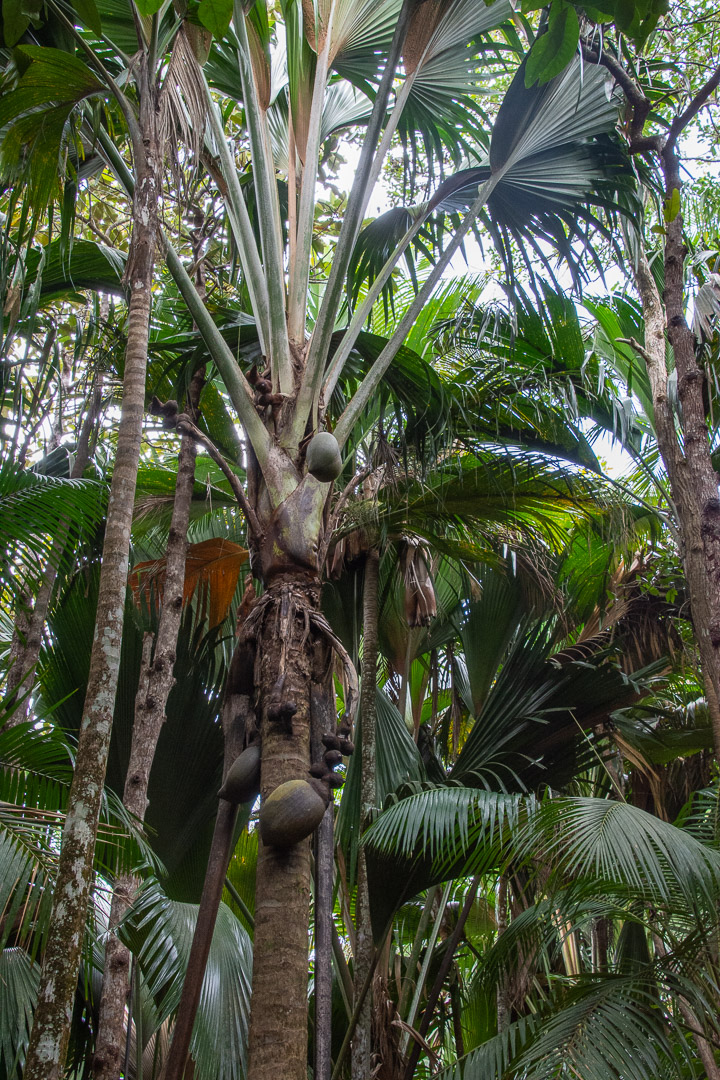
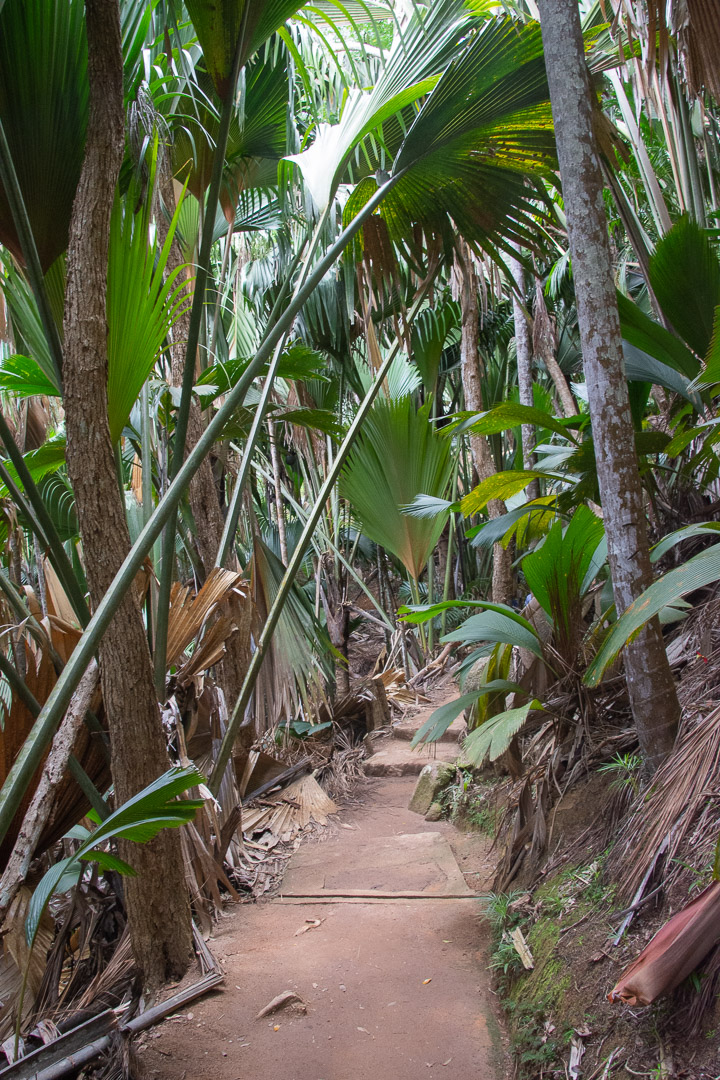
A walk through the Valle de Mer
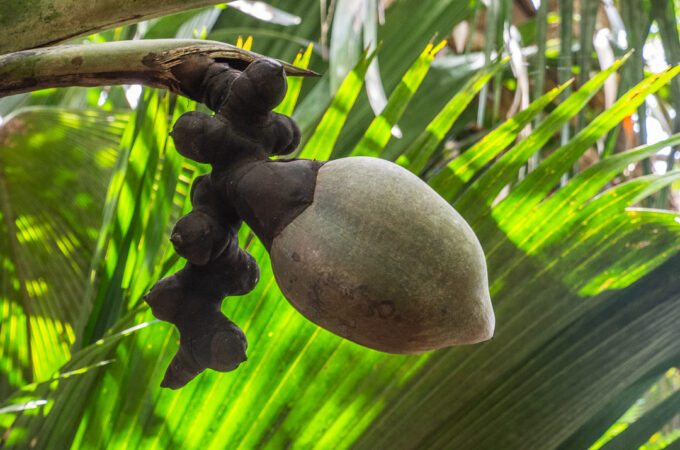
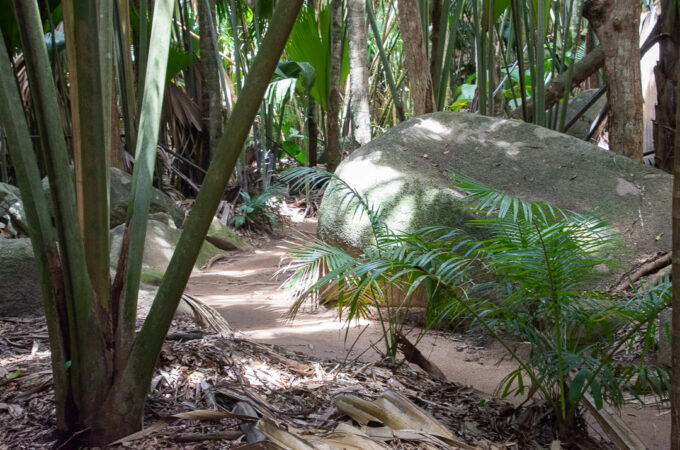
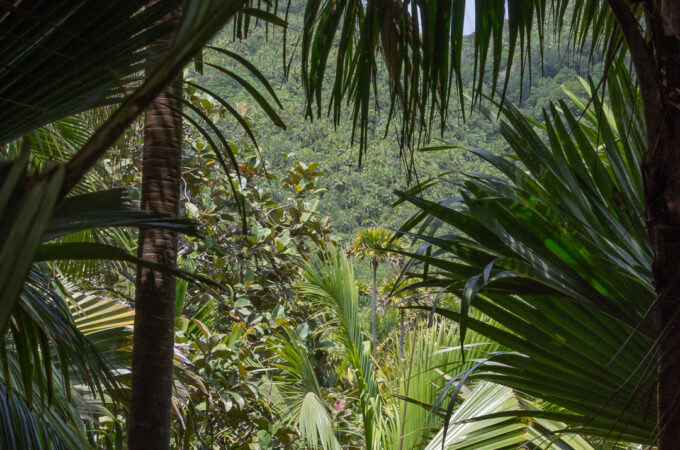
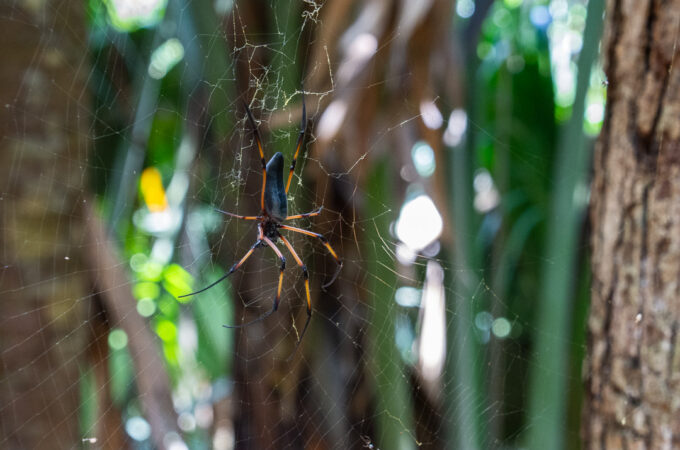
Top left: the fruit of the female coco de mer palm and, bottom right, a palm spider (about 4 inches across).
From Praslin we motored the 3 miles across to the island of La Digue and anchored outside the harbour along with a succession of charter catamarans which came and went each day. It was a particularly exposed anchorage and with around 15 knots of wind we were lulled to sleep each night by the rolling of the boat. La Digue is a delightful place which survives almost exclusively on its income from tourism. We sat drinking coffee in a restaurant by the beach, watching a small fishing boat distributing the day’s catch, before a stroll around the village and to a nearby beach.
We hired bicycles to cycle around the island, to the most popular and photographed beach on the island, Anse Source d’Argent, where we managed to eventually find a space along the narrow beach to eat our picnic lunch and have a swim. Then around the north of the island, until the numerous steep hills on the windy and exposed coast road defeated us.
The following day a taxi seemed the sensible way to get up the steep road to the Belle Vue restaurant, where you can take in the beautiful view across La Digue and over to Praslin whilst enjoying a wonderful fruit smoothie (and recovering from the exhausting walk up if you are a lot younger than us). From here we hiked and scrambled up the narrow and at times rather steep and terrifying path to the highest peak (333 metres) on La Digue, Nid d’Aigle – the Eagle’s Nest. ( I have to mention at this point that on our way up we passed a young couple on their way down who’d only made it half way before giving up and turning back; they blamed their footwear… flipflops are probably not the best idea). Once at the very top we had our pack lunch and thankfully found a rather easier and more enjoyable route down, then walked back to the harbour, getting caught in a tropical storm half way.
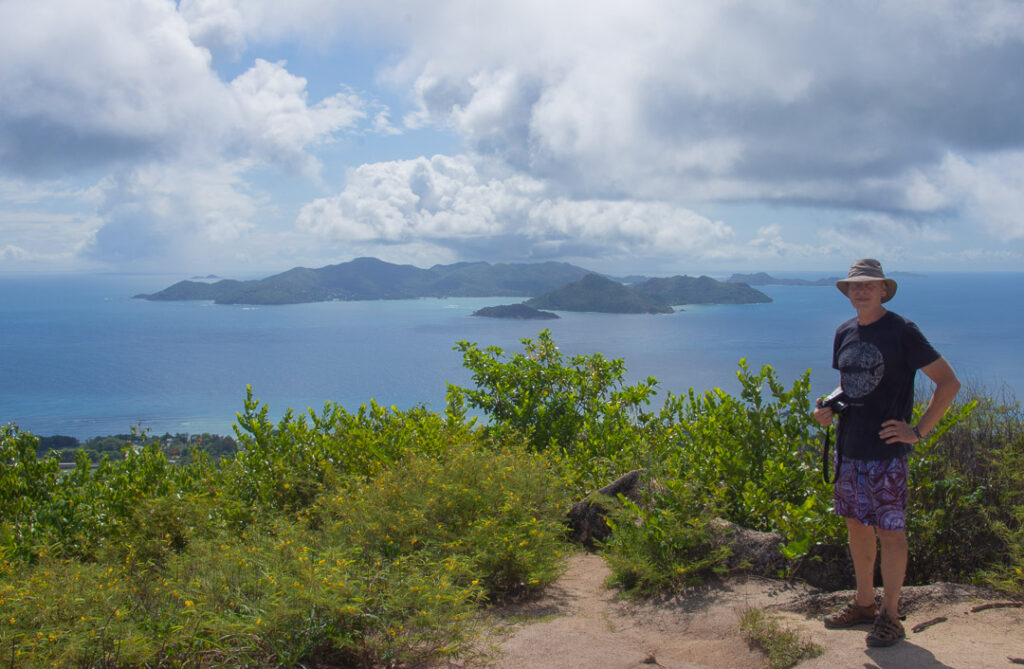
At the end of our two weeks of island cruising we had a great sail back to Mahé, and anchored by Eden island, only a short dinghy ride across to the marina and its facilities. We still had a few more jobs to get sorted on the boat, provisioning for the next passage and a mountain of washing to take to the laundry. It is peaceful here, sheltered from strong winds (and free!) and at dusk flying foxes wing their way over the anchorage (they are the Seychelles’ only indigenous mammal, their favourite food being mangoes… I thought you’d find that interesting).
Our friends Jon on Hecla and Colin and Izzi on Endorphin Beta are waiting to continue on to South Africa on a similar time scale to us. Ben and Ashley with their two young children on catamaran Nahoa will be a few weeks later (they have a popular YouTube vlog – ’Sailing Nahoa’). Several other boats that we met along the way had continued west to Tanzania from the Seychelles and will soon be heading down to South Africa from there. Others went north towards Socotra and the Red Sea. When we first arrived we got to know Kim, a Danish guy, who left the Seychelles a few weeks ago for the Red Sea, sailing single handed. In strong winds and rough seas first his foresail ripped and was lost, then his mainsail collapsed as the shackle on the hallyard, the line which raises the sail, broke. He motored on until the gear box on his engine also broke. With no spare sails and no functional engine he put out an emergency VHF call and was fortunate to be helped by a cargo ship, suffering only minor injuries but losing everything, as he was hauled aboard from the deck of his yacht in what looked like a terrifying rescue. He is now back in Denmark and messaged me ‘I am here to tell the story, that’s what matters, and my grandchildren think they have the toughest grandpa’.
Whilst we waited for the right weather to leave the Seychelles and wanting a change of scenery, we joined Jon, Colin and Izzi at anchor in the bay at Beau Vallon, on the west side of Mahé. We rolled around for three days whilst the wind blew too strongly to try to get ashore in the big surf, let alone launch our dinghy. When the wind eased we headed along the coast and spent a couple of nights in Anse Jasmine, a tiny bay where we were alone apart from the occasional day boat bringing snorkellers and scuba divers. I had been myself for a snorkel when we first arrived when, the following day, a dark shadow at least 15 foot long, following in the wake of a large catamaran full of day trippers, glided around the bay just under the surface of the water. Was it a great white shark or a juvenile whale shark? – they are both known in Seychelles waters. After that I gave up swimming there.
In the meantime we followed events at home with sadness and horror. Sadness at the death of Queen Elizabeth II and with admiration for her life of dignity and dedication. Horror as Liz Truss became our new prime minister, with shock and incredulity (sadness too) as her ‘mini-budget’ was unveiled which almost entirely benefits the wealthy in our country whilst saddling future generations with massive debt, and we watch as the pound nose-dives. Sometimes it’s better to be far away.
We are now ready to leave for South Africa. The first stage of the voyage is about 800nm to the French island of Mayotte, west of the top of Madagascar. Mayotte makes a good stopping point to rest before continuing on down the dreaded Mozambique Channel to Richard’s Bay in South Africa. Mayotte has lemurs as well as baguettes, French cheeses and wines, so we’re not too disappointed to miss Madagascar, which has only just recently opened again to private yachts.
We have been waiting for the strong winds, which are common in the ‘compression zone’ around the top of Madagascar, to ease. Otherwise winds of 25 to 30+ knots with gusts of 35+ knots and waves of 3 metres and much more are the norm, which would make for an unpleasant few days sailing. It will take us about 3 days sail from Seychelles to reach this area so we needed to be ready to leave at short notice when the forecast looked favourable. Such a weather window has now appeared with a gap in the very strong winds, which should hopefully not be more than 25 knots around the top of Madagascar.
This is what we’re hoping for in 3-4 days time:
We have checked out of the Seychelles and are anchored in the bay of Beau Vallon, planning to leave tomorrow, Friday 30th September, at first light. Wish us luck!

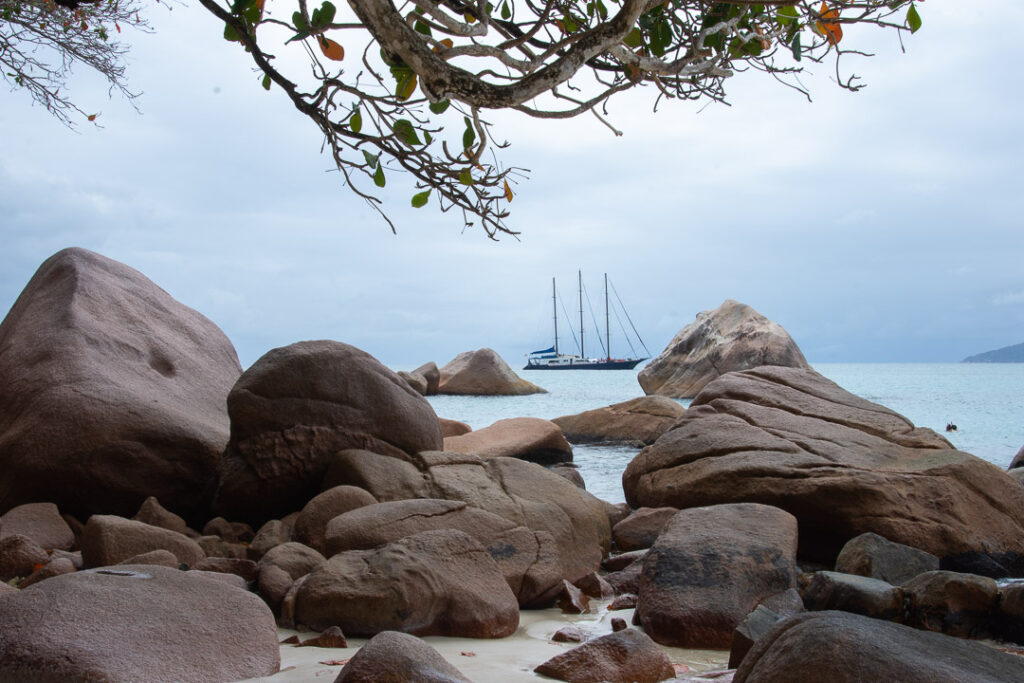
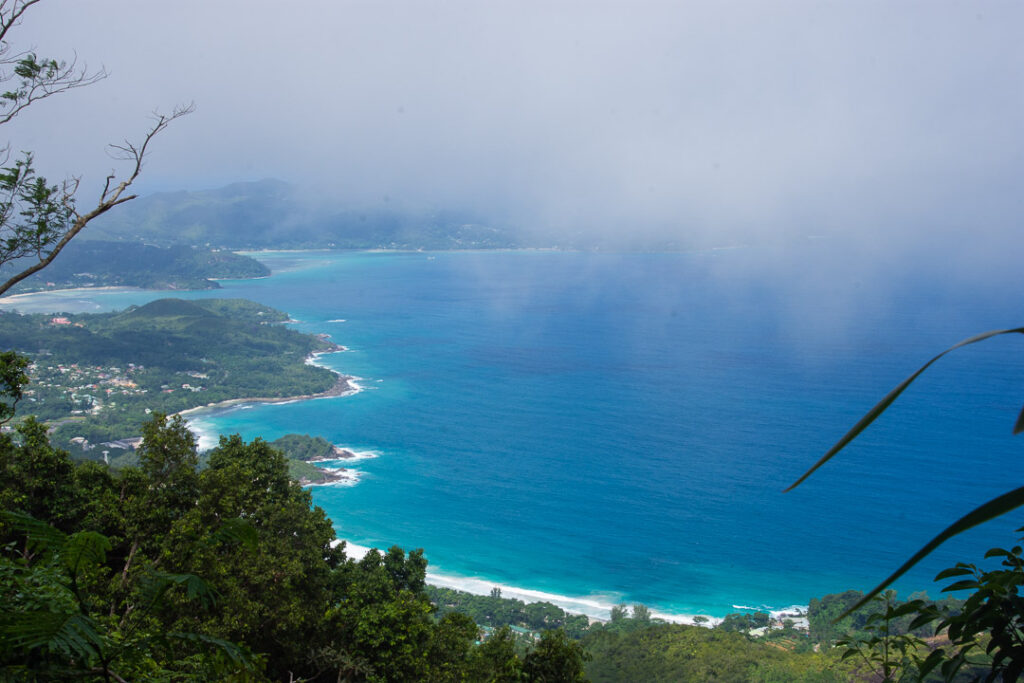
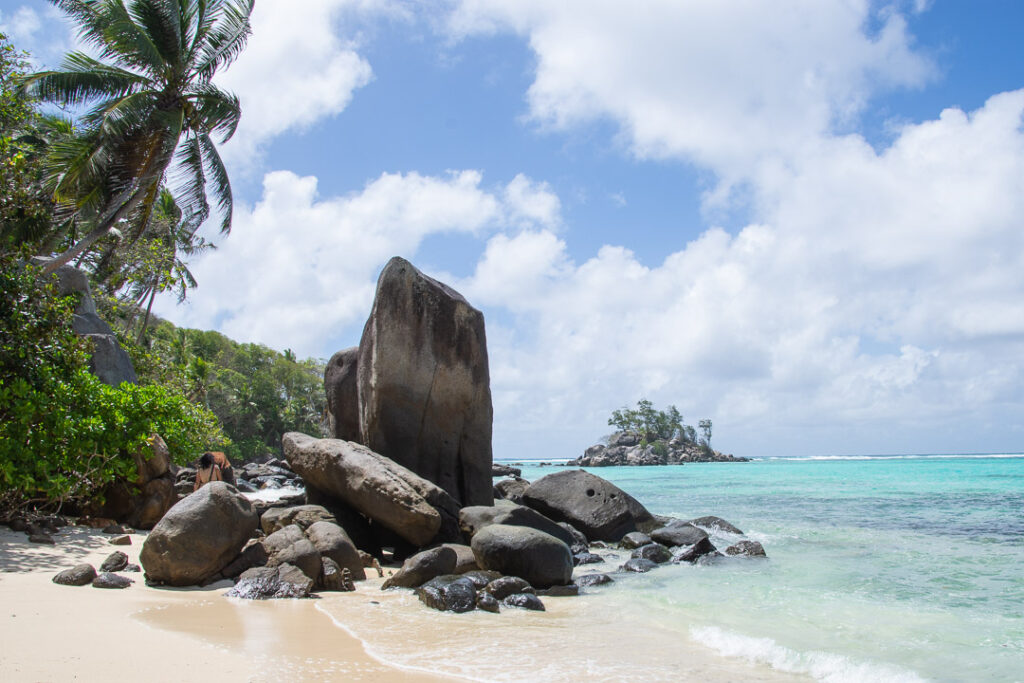
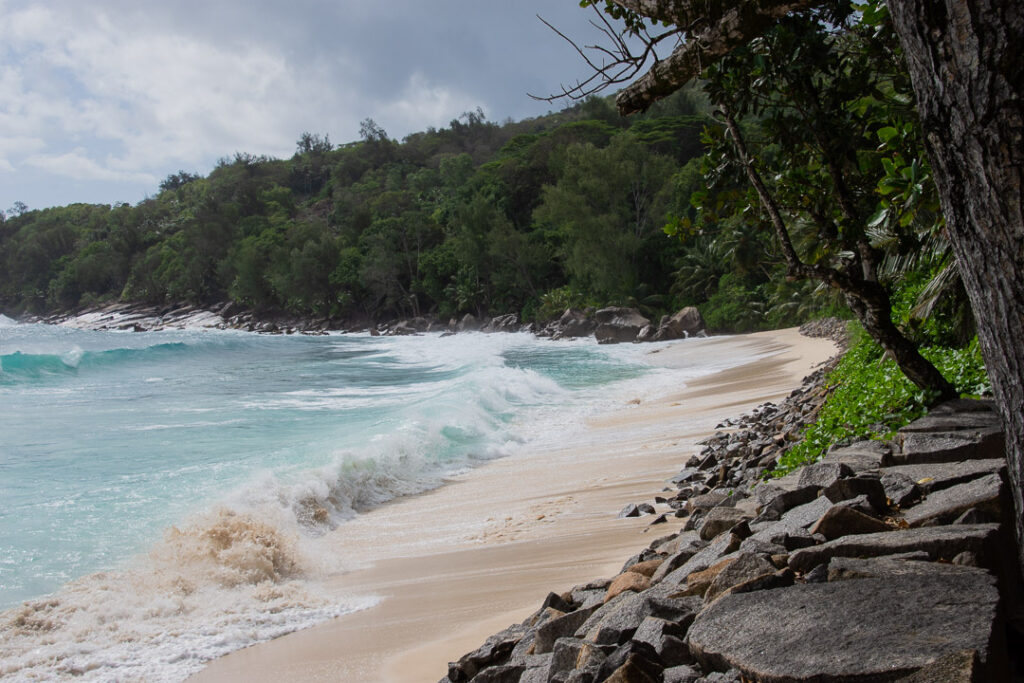
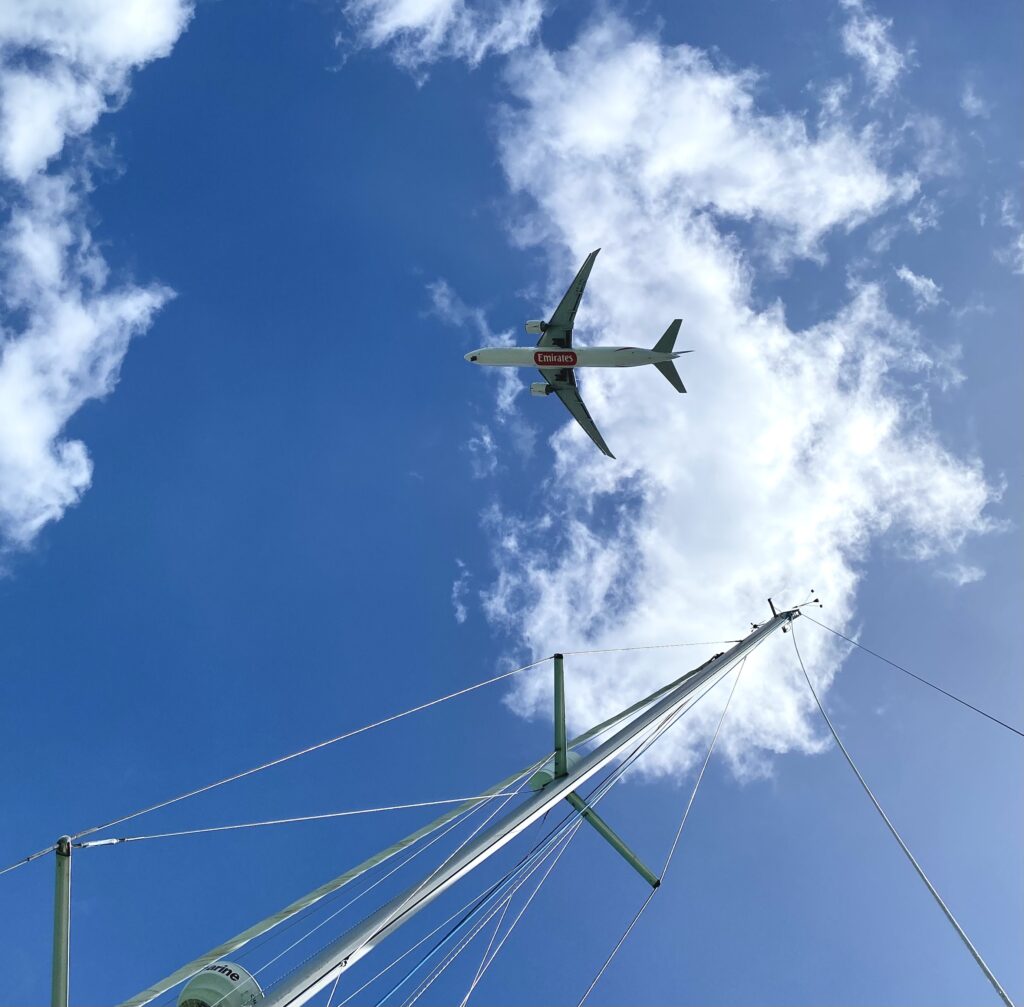
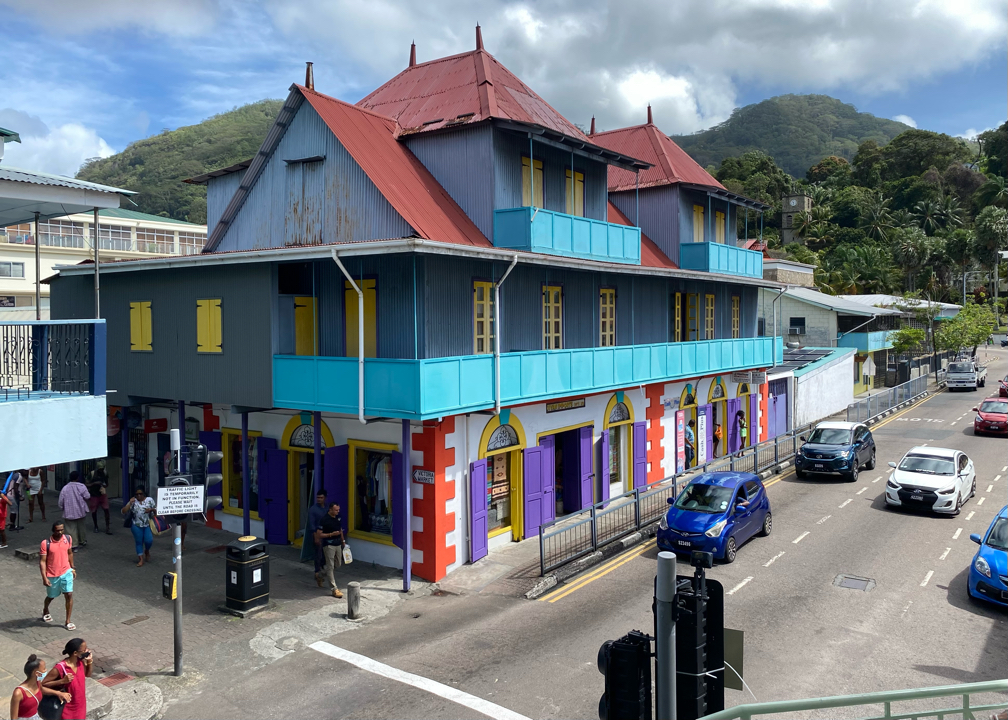
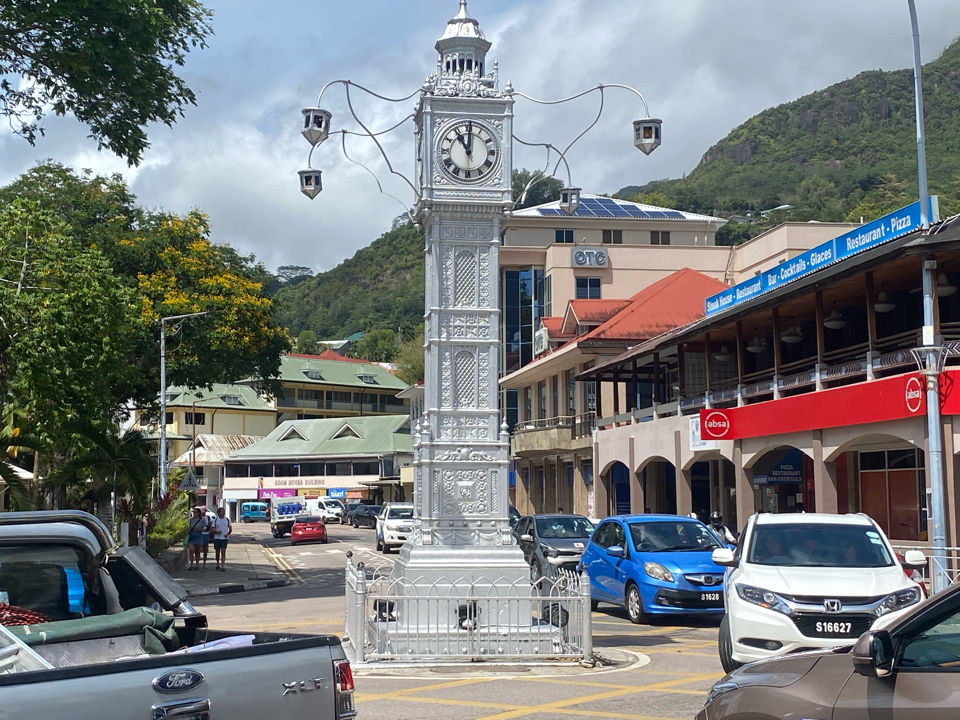
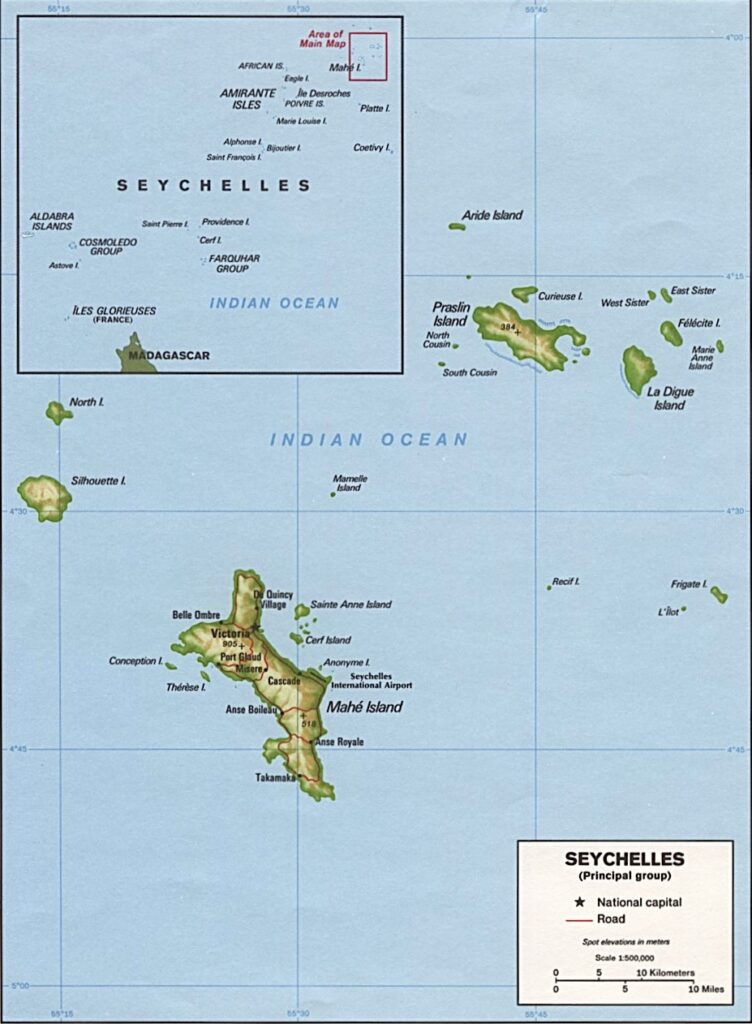
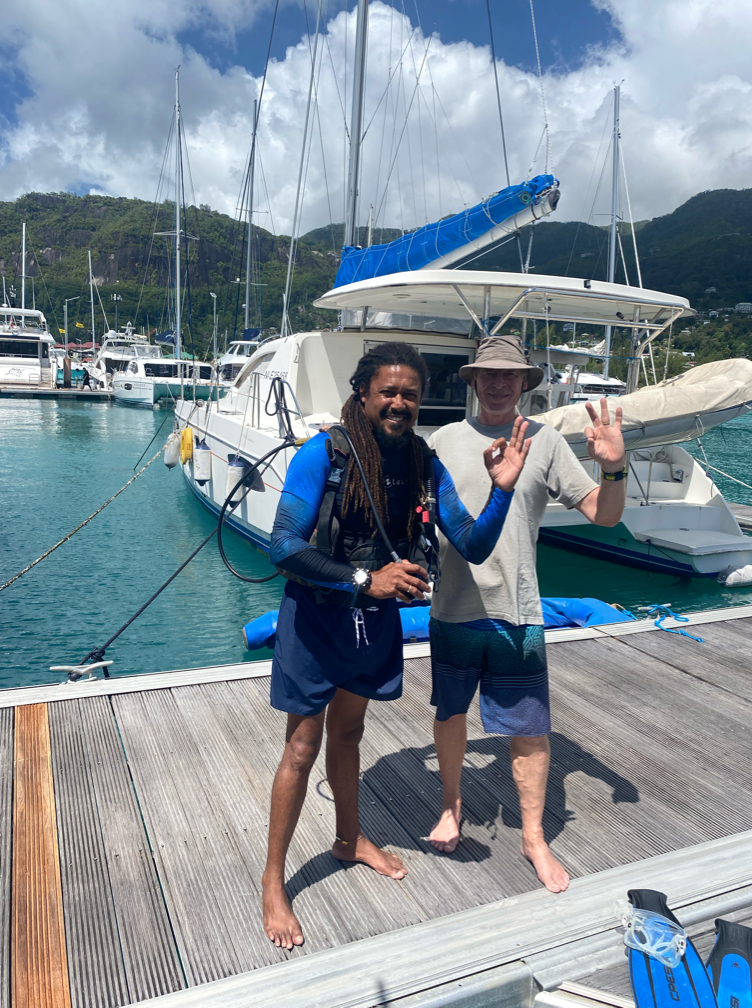
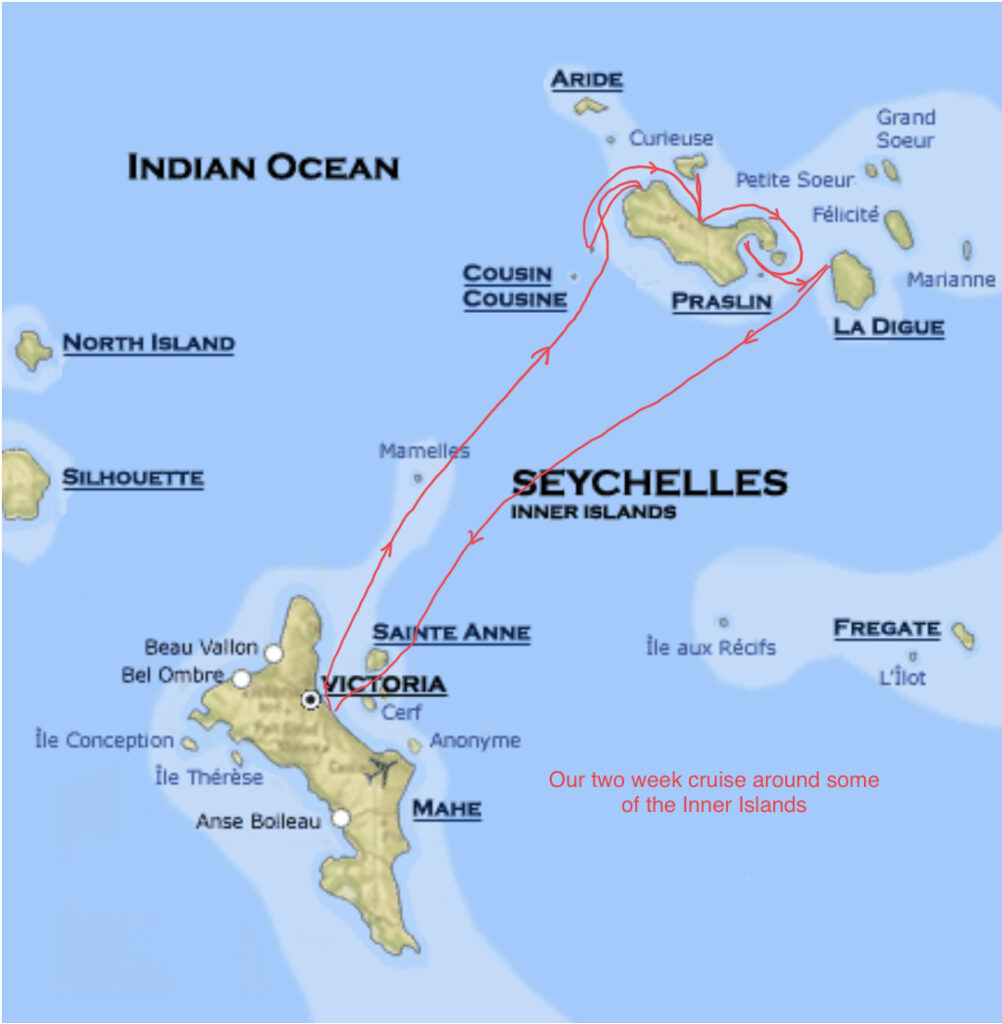
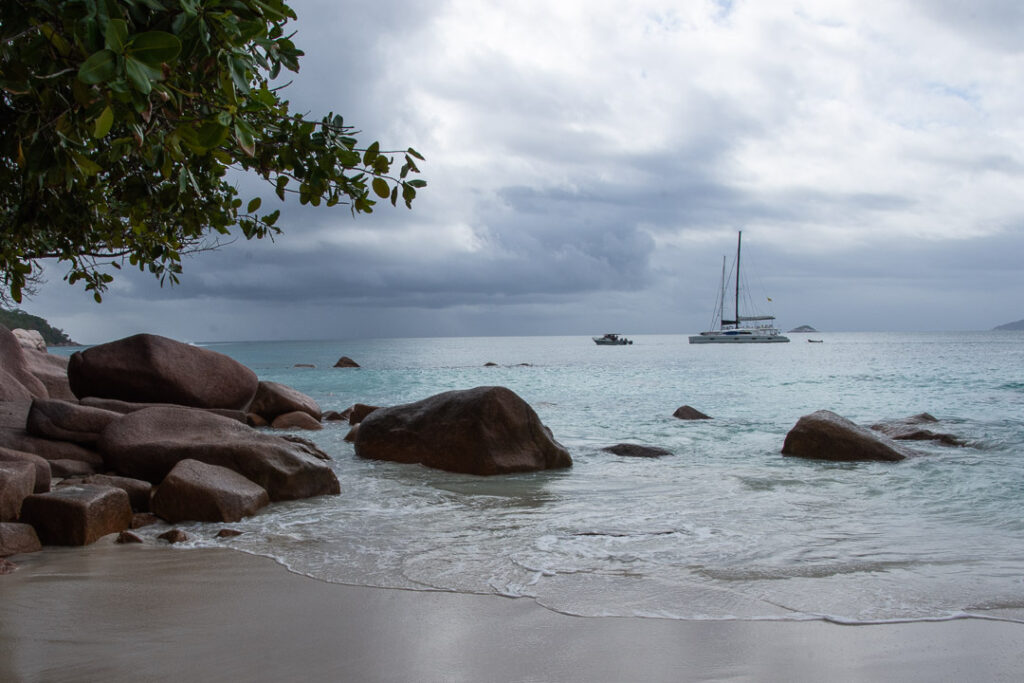
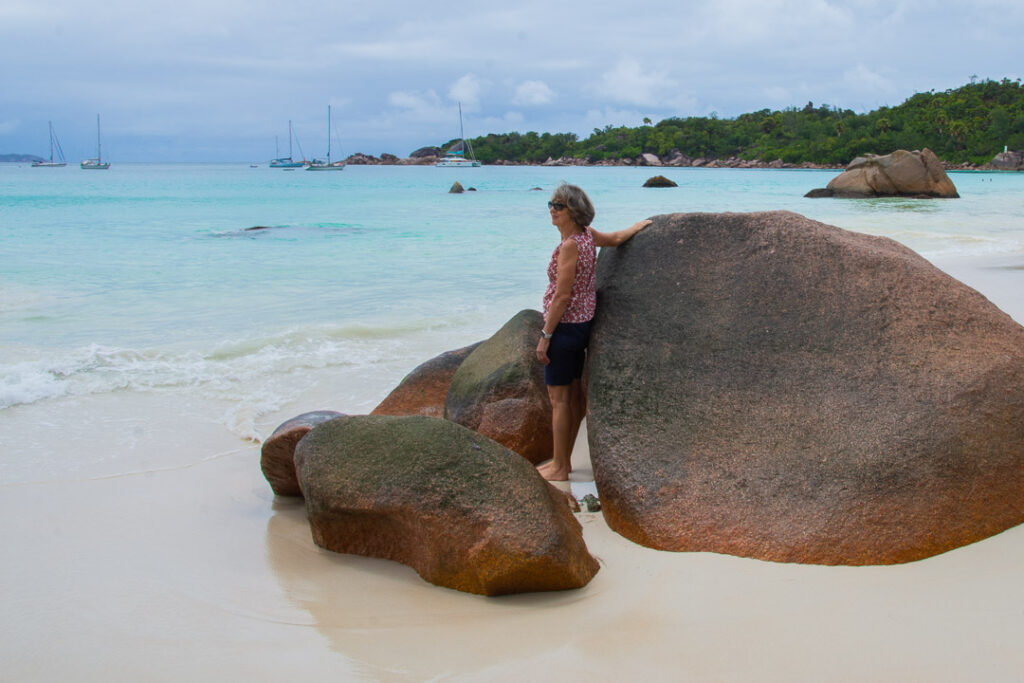
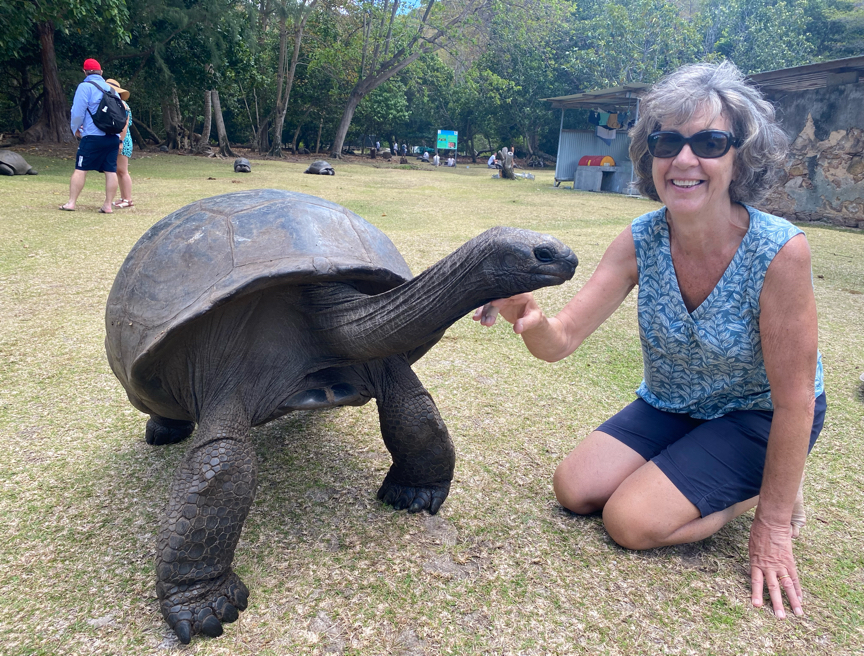
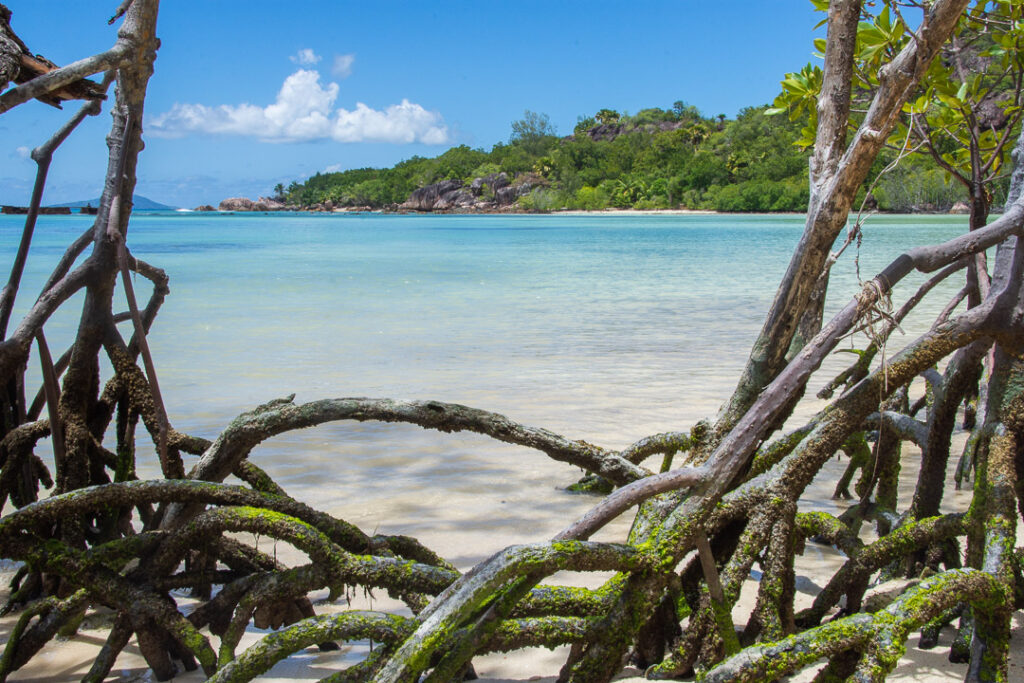
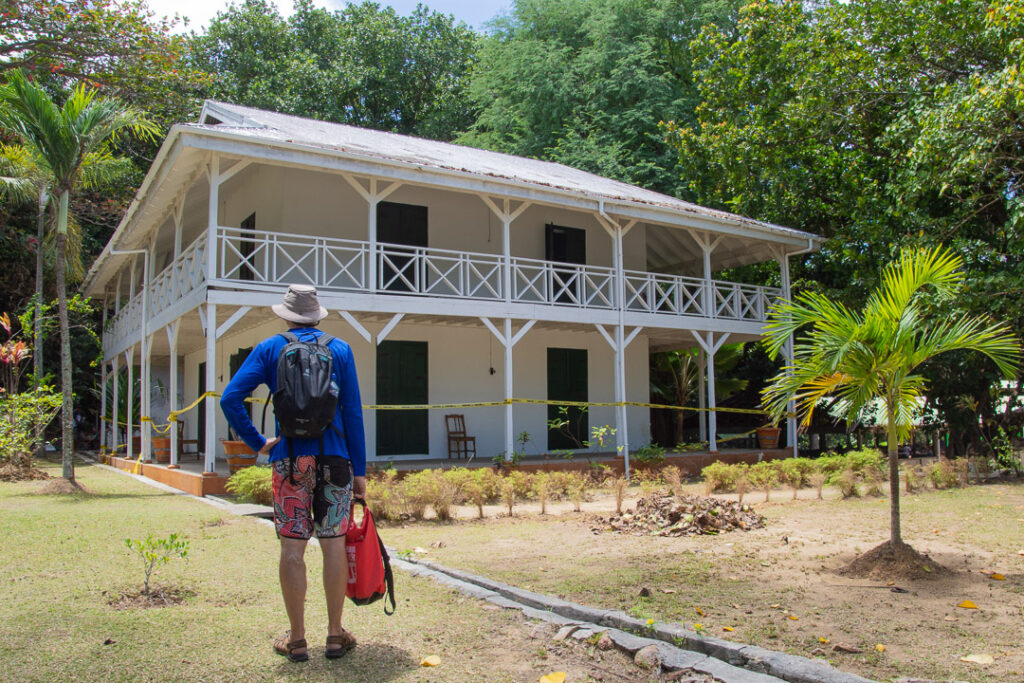
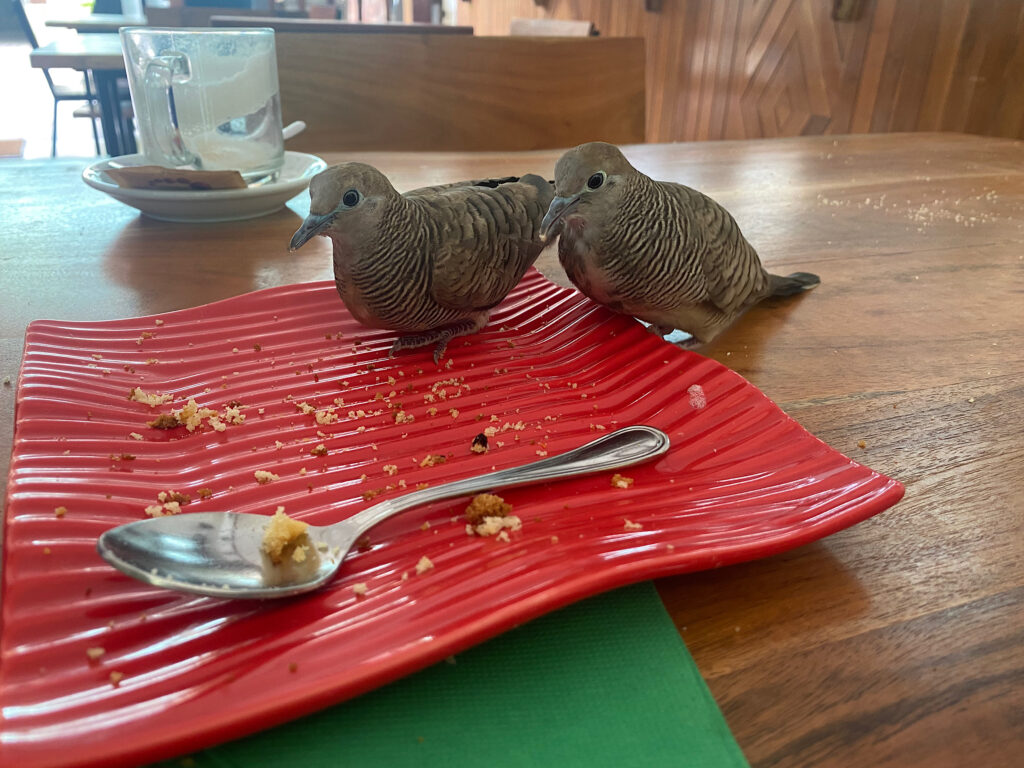
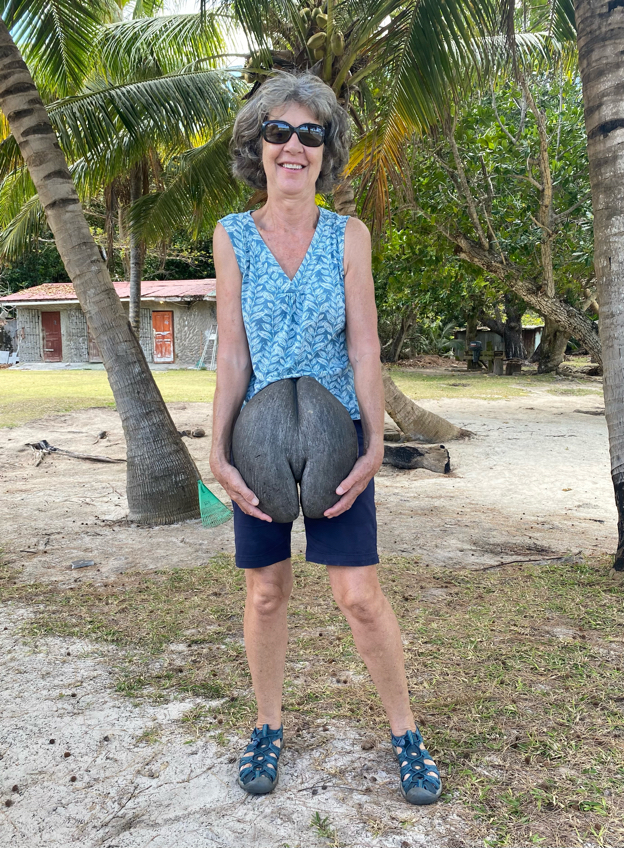
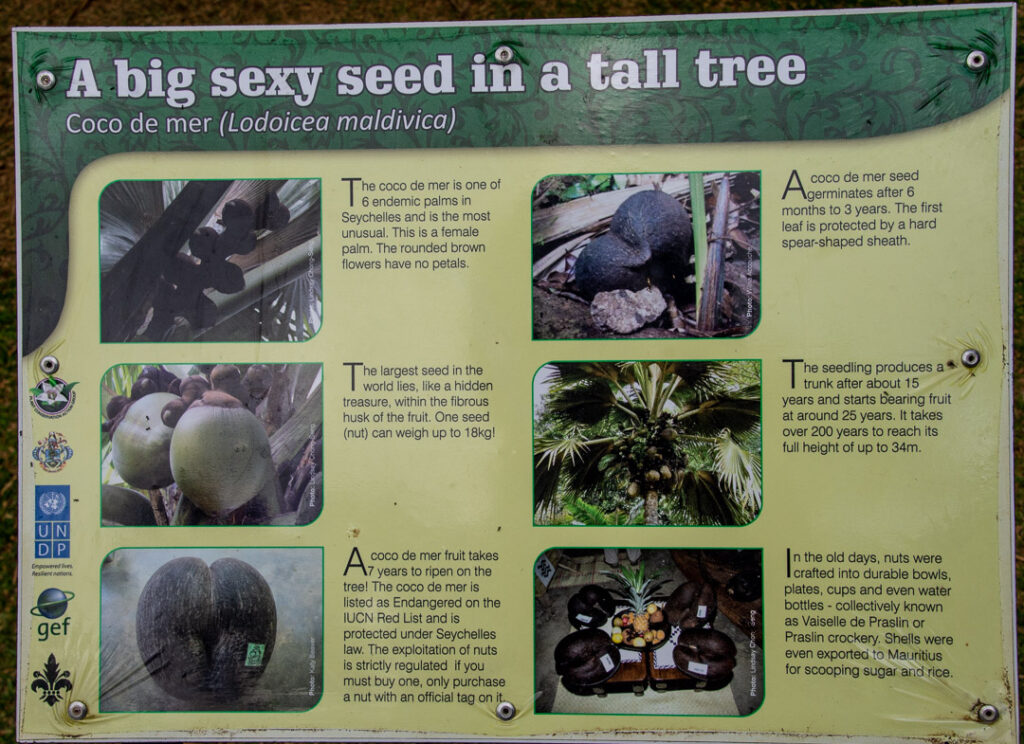
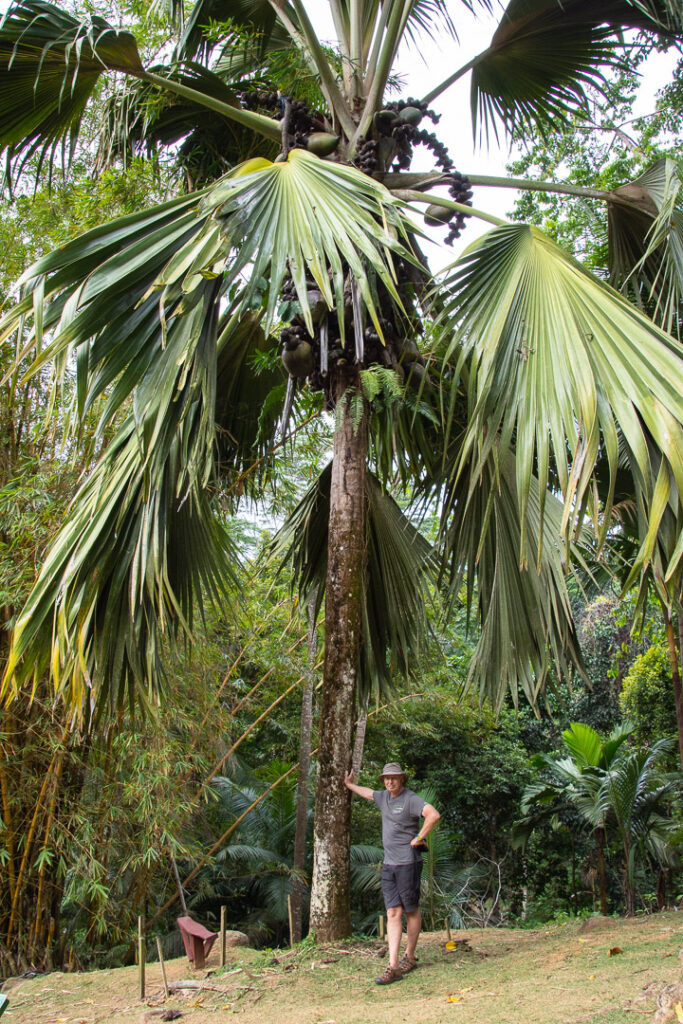
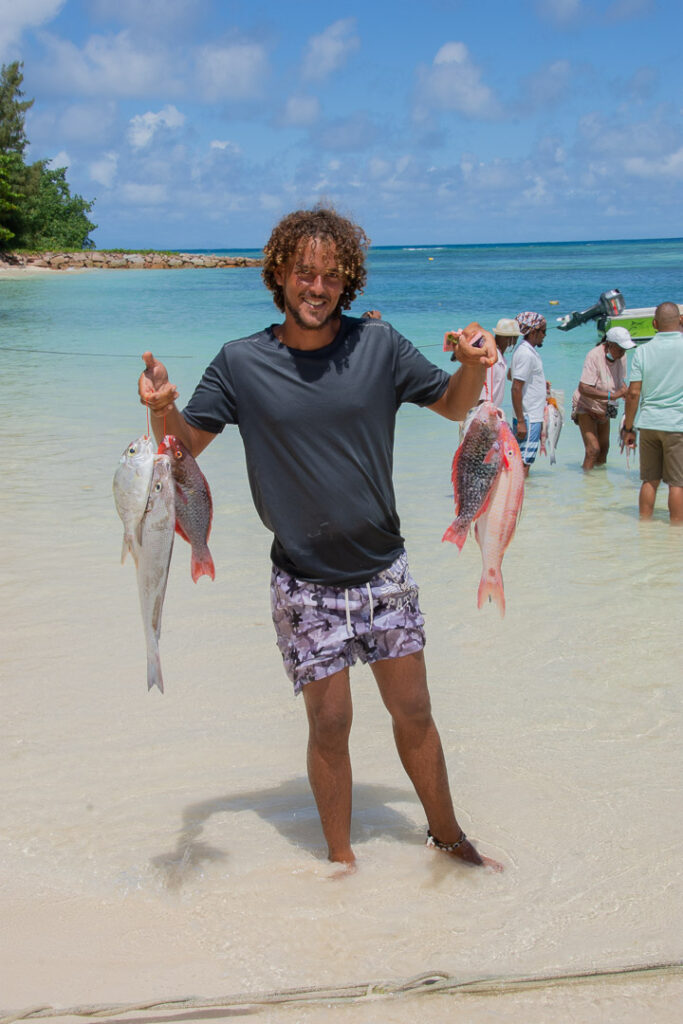
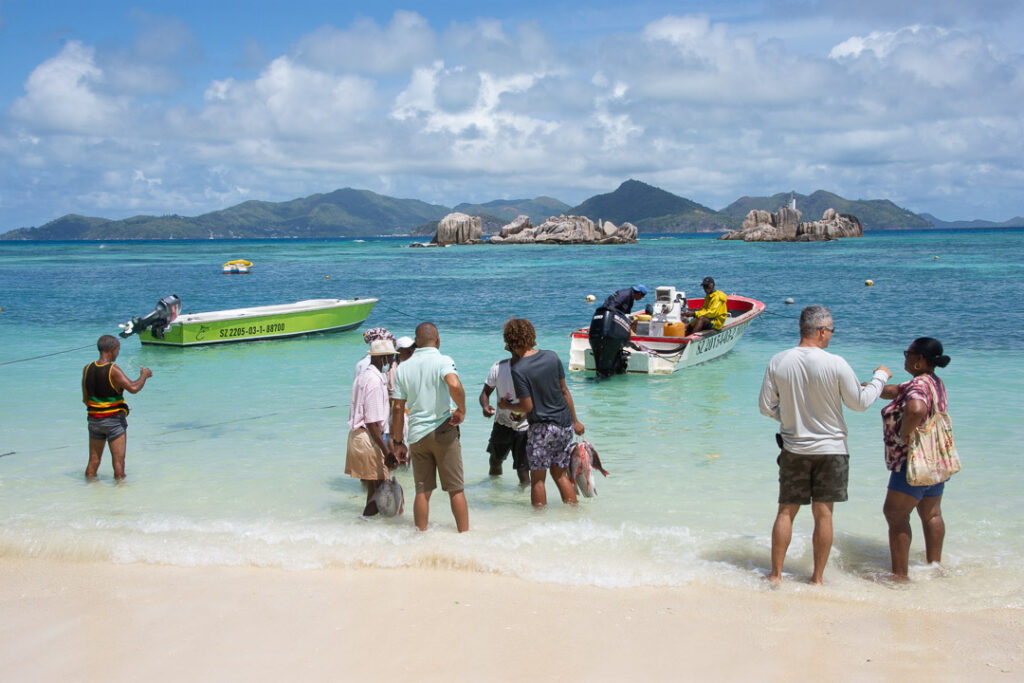
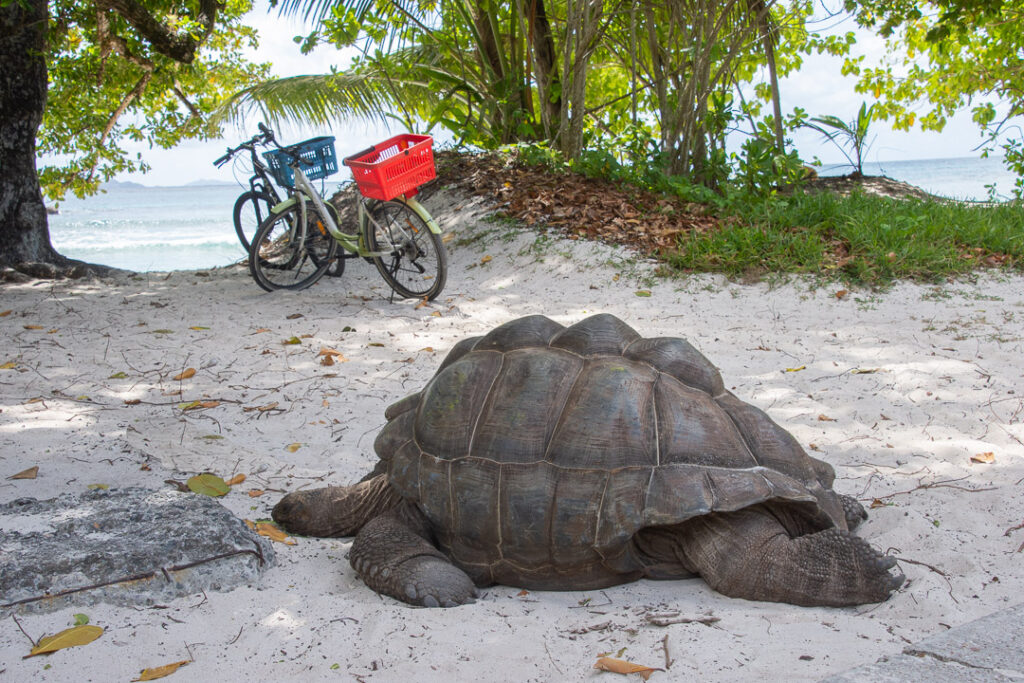
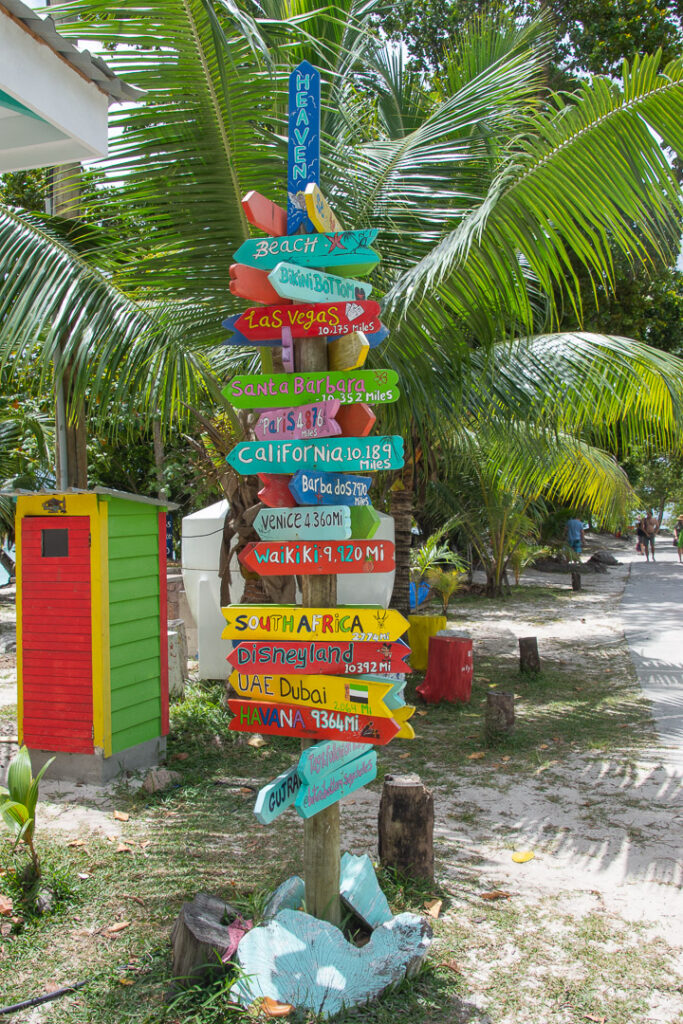
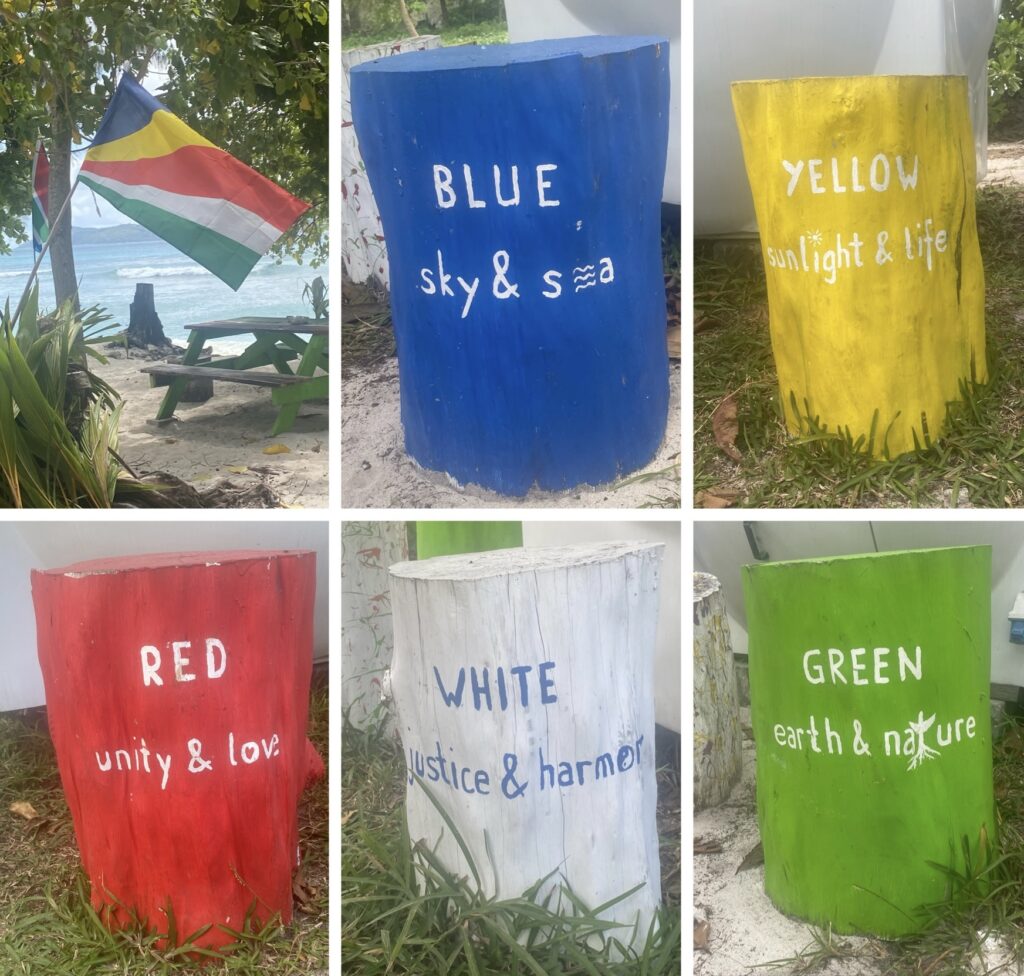
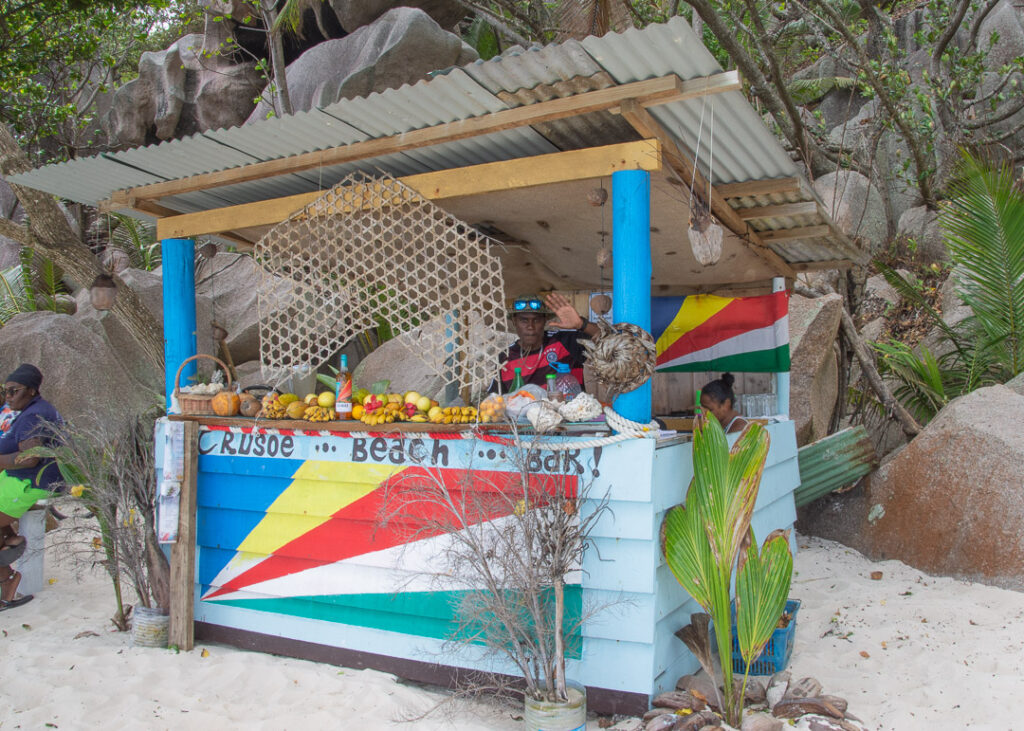
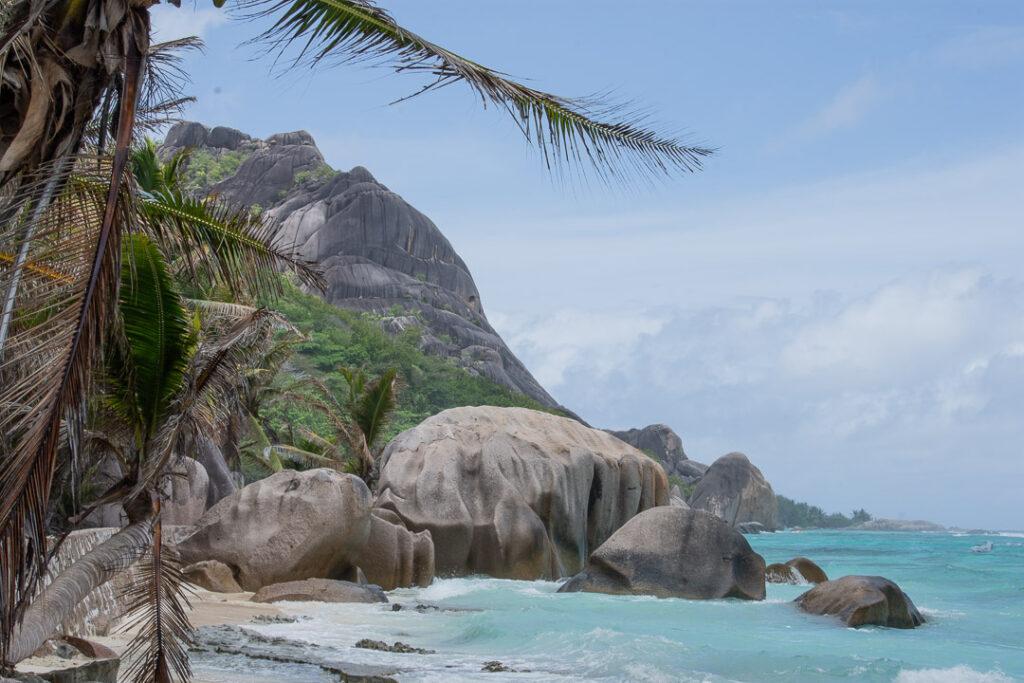
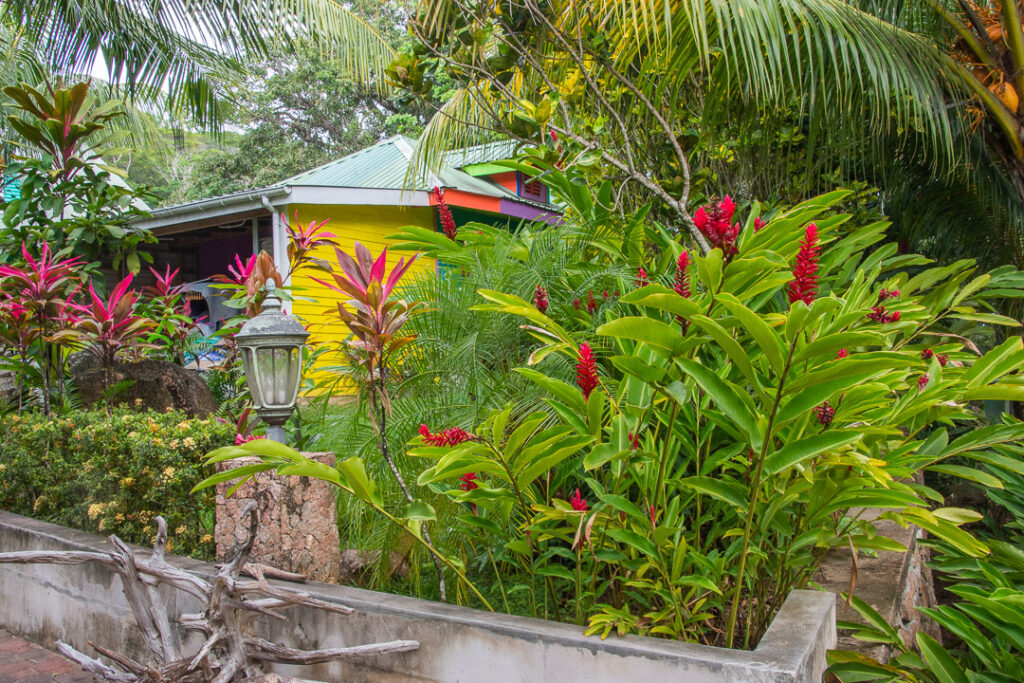
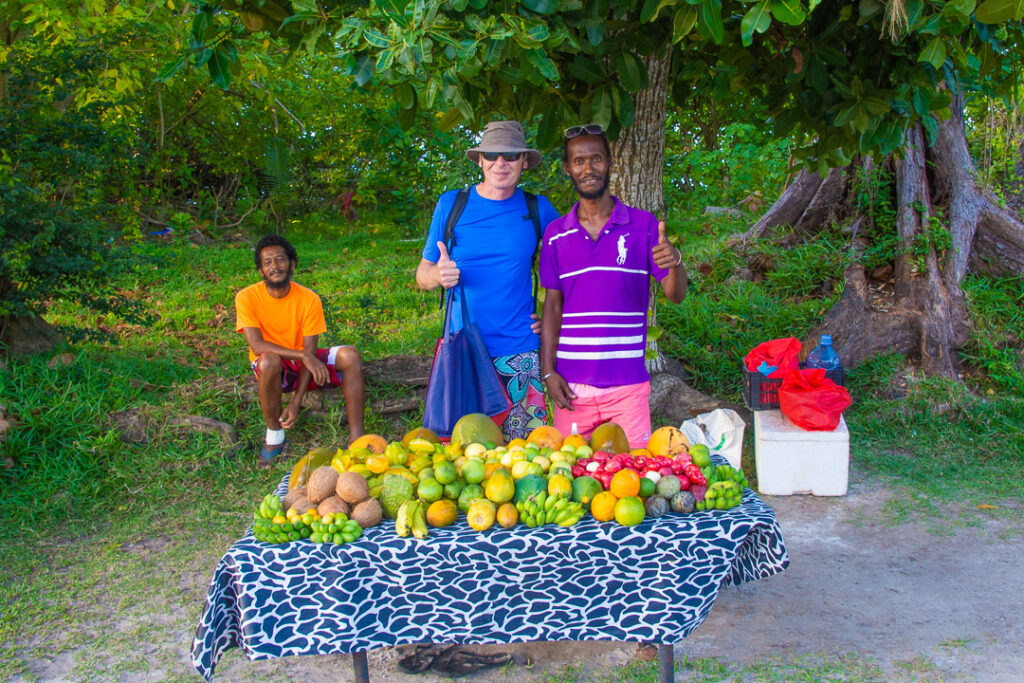
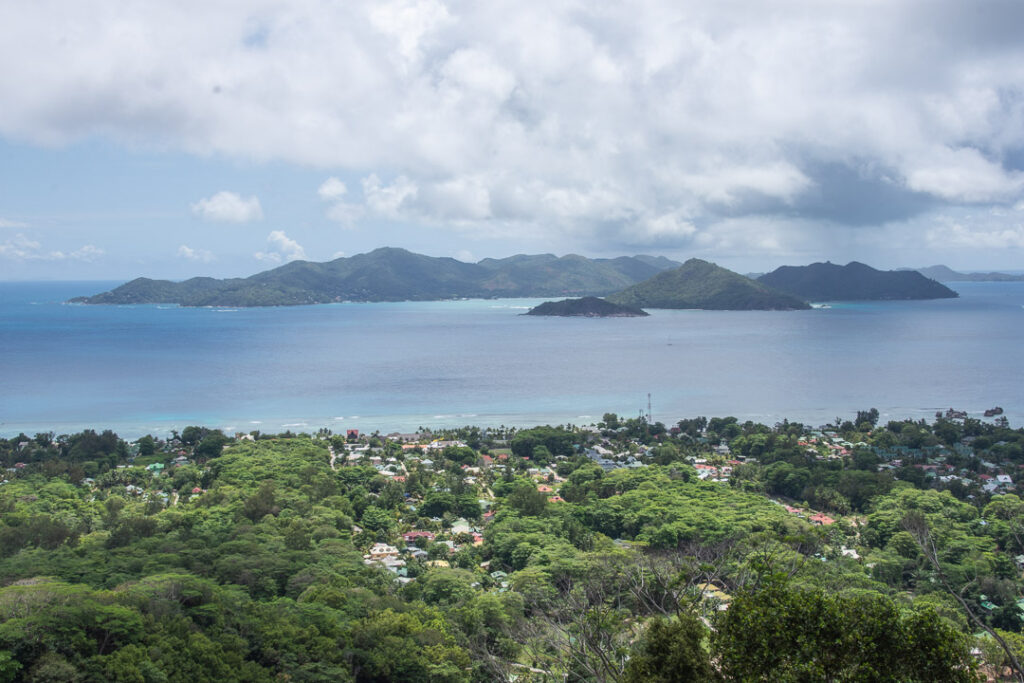
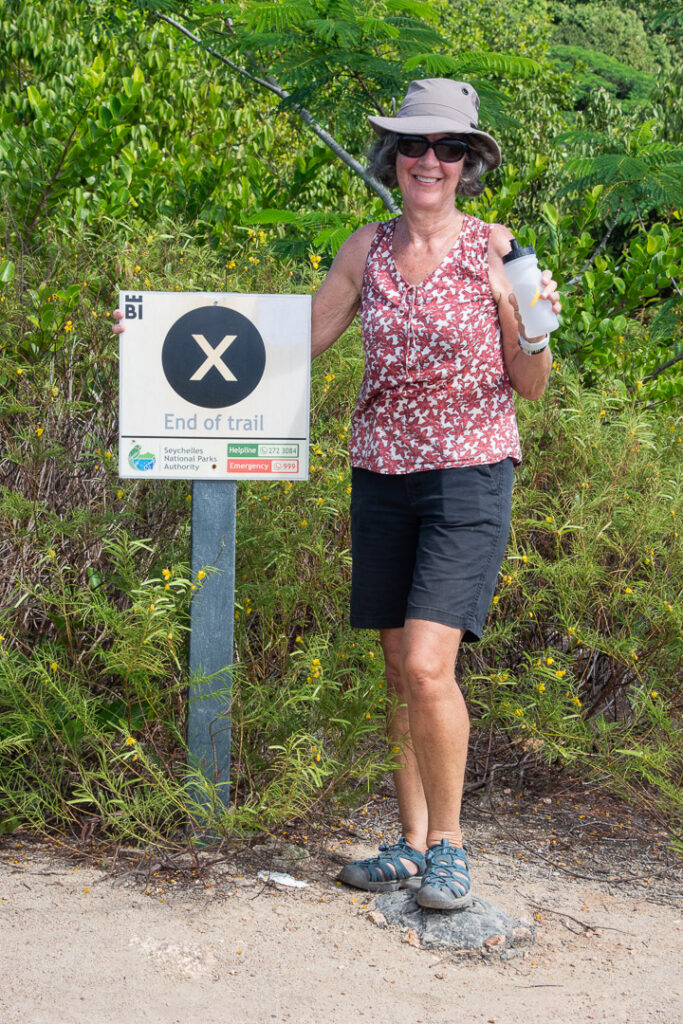
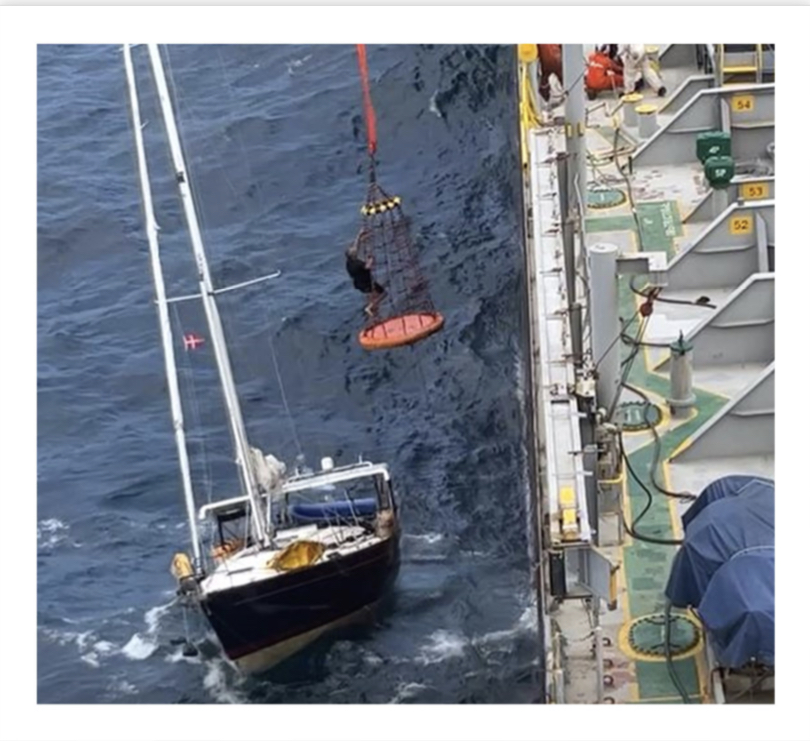
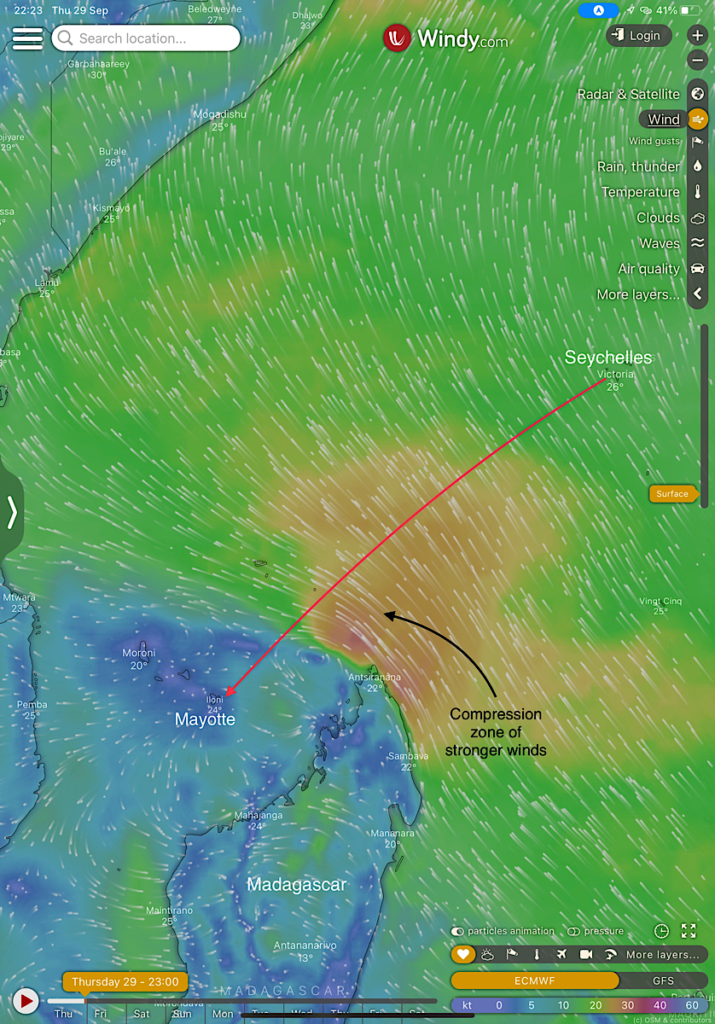
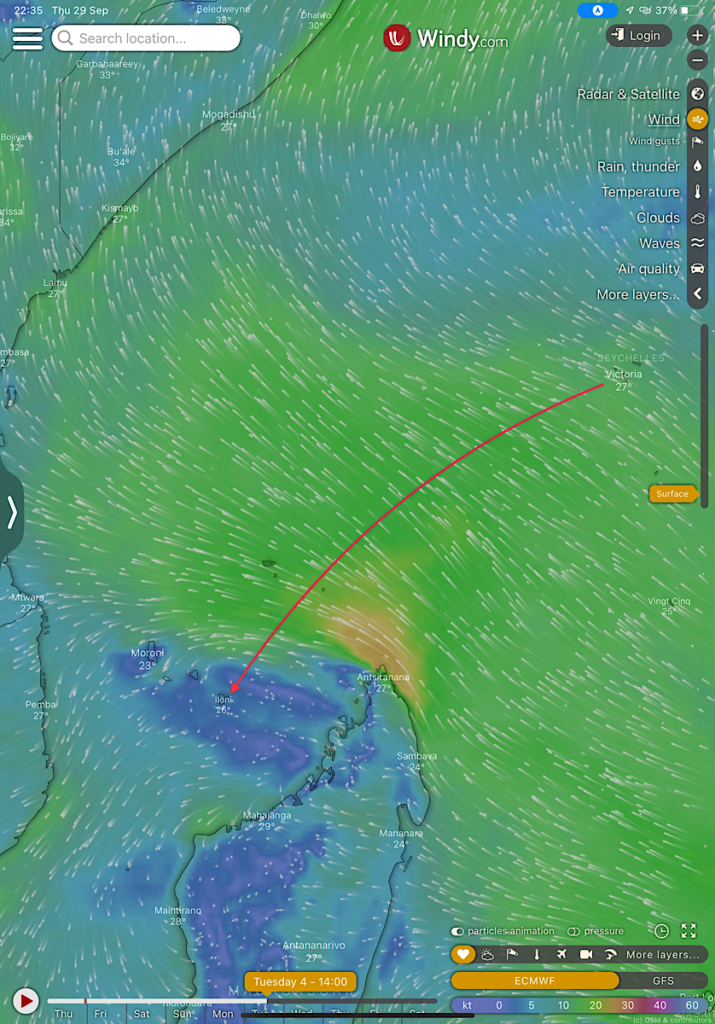
12 Comments
Peter Baylis
September 29, 2022 - 8:40 pmThanks Annie. An excellent and informative account. Loved the tortoise stroking bit. Good luck and fair winds to South Africa.
Pete.
Gerard
September 30, 2022 - 7:41 pmBy the time you finally get home I will feel that i have been around the world as well . Good luck and fair winds for South Africa.
annie
October 9, 2022 - 12:39 pmThanks Gerard. Glad we’ve got you along for the voyage 😉
annie
October 9, 2022 - 12:44 pmThanks Pete.
Fran
September 29, 2022 - 9:09 pmGreat blog, it looks a fascinating place. I’m not sure if you’ll get your Wordle in tomorrow morning! Will miss you until you get to Mayotte. I am constantly amazed at how we can be “chatting” and playing games while being so far apart. In a funny sort of way we were more isolated when we were cruising the Med 20 years ago!
“See” you on the other side, have a safe passage. Love Fxx
annie
October 9, 2022 - 12:43 pmThanks Fran. I’ve been missing my daily Wordle!
Tuija
September 29, 2022 - 9:28 pmNice reading and beautiful photos.
Fare winds and safe sailing
Tuija&Ingvar
annie
October 9, 2022 - 12:43 pmThanks Tuija.
Jos
September 30, 2022 - 6:45 amThanks Annie, really enjoyed your account of the past few months in such a beautiful part of the world. Safe passage for your next leg. X
annie
October 9, 2022 - 12:42 pmThanks for reading, Jos. I wasn’t looking forward to the next passage but we made it!
Paul Bayley
September 30, 2022 - 3:59 pmWow a great post again some really great photo’s, again some of the experience sounded a bit frightening. Hope all goes well on the next leg.
annie
October 9, 2022 - 12:41 pmThanks Paul. We loved Seychelles and the next passage wasn’t as bad as feared.